

‘I Feel Your Pain’: The Neuroscience of Empathy
- Developmental Psychology
- Forecasting
- Neuroscience
- Sensory Systems

Whether it’s watching a friend get a paper cut or staring at a photo of a child refugee, observing someone else’s suffering can evoke a deep sense of distress and sadness — almost as if it’s happening to us. In the past, this might have been explained simply as empathy, the ability to experience the feelings of others, but over the last 20 years, neuroscientists have been able to pinpoint some of the specific regions of the brain responsible for this sense of interconnectedness. Five scientists discussed the neuroscience behind how we process the feelings of others during an Integrative Science Symposium chaired by APS Fellow Piotr Winkielman (University of California, San Diego) at the 2017 International Convention of Psychological Science in Vienna.
Mirroring the Mind

Cultural emphasis on ingroups and outgroups may create an “empathy gap” between people of different races and nationalities, says Ying-yi Hong .
“When we witness what happens to others, we don’t just activate the visual cortex like we thought some decades ago,” said Christian Keysers of the Netherlands Institute for Neuroscience in Amsterdam. “We also activate our own actions as if we’d be acting in similar ways. We activate our own emotions and sensations as if we felt the same.”
Through his work at the Social Brain Lab, Keysers, together with Valeria Gazzola, has found that observing another person’s action, pain, or affect can trigger parts of the same neural networks responsible for executing those actions and experiencing those feelings firsthand. Keysers’ presentation, however, focused on exploring how this system contributes to our psychology. Does this mirror system help us understand what goes on in others? Does it help us read their minds? Can we “catch” the emotions of others?
To explore whether the motor mirror system helps us understand the inner states behind the actions of others, Keysers in one study asked participants to watch a video of a person grasping toy balls hidden within a large bin. In one condition, participants determined whether or not the person in the video hesitated before selecting a ball (a theory-of-mind task). Using transcranial magnetic stimulation (TMS) in combination with fMRI, Keysers showed that interfering with the mirror system impaired people’s ability to detect the level of confidence of others, providing evidence that this system indeed contributes to perceiving the inner states of others. Performing fMRI and TMS on other brain regions such as the temporoparietal junction (TPJ) further suggests that this motor simulation in the mirror system is then sent onward to more cognitive regions in the TPJ.
“Very rapidly, we got this unifying notion that when you witness the states of others you replicate these states in yourself as if you were in their shoes, which is why we call these activities ‘vicarious states,’” Keysers said.
Studies have suggested that this ability to mentalize the experiences of others so vividly can lead us to take prosocial steps to reduce their pain, but Keysers also wanted to investigate the depth of this emotional contagion — how and to what extent we experience other people’s suffering. To do this, Keysers’ lab studied two very different populations: human psychopaths and rats.
While witnessing the pain of others is correlated with activity in the insula, which is thought to contribute to self-awareness by integrating sensory information, and the anterior cingulate cortex (ACC), which is associated with decision making and impulse control, the researchers found that psychopaths who passively observed an aggressor twisting someone’s hand exhibited significantly less brain activity than their neurotypical peers. When the psychopathic individuals were asked to attempt to empathize with the person in the video, however, their brain activity increased to baseline levels.
This suggests that the current model of empathy as a one-dimensional scale with empathic individuals at one end and psychopaths at the other may be overly simplistic, Keysers said.
“Psychopaths are probably equally high on ability, it’s just that they don’t recruit this spontaneously, so their propensity is modified,” he explained.
These findings could lead to more effective interventions for psychopathic individuals, as well as to future research into where people with autism spectrum disorders may fall on these axes.
Shared Pain
Studies of emotional contagion in animal models have allowed researchers to further examine the role of deep brain activity, which can be difficult to neurostimulate in humans. Keysers’ work with rats has found that these animals are more likely to freeze after watching another rat receive an electric shock if they themselves had been shocked in the past.
Inhibiting a region analogous to the ACC in the rats’ brains reduced their response to another rat’s distress, but not their fear of being shocked themselves, suggesting that the area deals specifically with socially triggered fear, Keysers said.
Claus Lamm, University of Vienna, investigates the processes that regulate firsthand pain and those that cause empathy for pain through numerous studies on the influence of painkillers.
In these experiments, participants who took a placebo “painkiller” reported lower pain ratings after receiving a shock than did those in the control group. When those same participants watched a confederate get shocked, they reported a similar drop in their perception of the actor’s pain.
“If you reduce people’s self-experienced pain, if you induce analgesia, that not only helps people to deal with their own pain, but it also reduces empathy for the pain of another person,” Lamm said.
On the neural level, Lamm said, fMRI scans showed that people in the placebo group displayed lower levels of brain activity in the anterior insula and mid cingulate cortex in both cases. These results were further confirmed in another study that compared participants who received only the painkiller placebo with those who received both the placebo and naltrexone, an opioid antagonist that prevents the brain from regulating pain.
This resulted in a “complete reversal” of the placebo effect, causing participants to report both their own pain and the pain of others at near baseline rates, supporting Lamm’s previous claims about the pain system’s role in empathy.
“This suggests that empathy for pain is grounded in representing others’ pain within one’s own pain systems,” Lamm said.
The Self/Other Divide
Empathy may not give us a full sense of someone else’s experiences, however. When observers in one of Keysers’ studies were given the opportunity to pay to reduce the severity of the electric shocks a confederate was about to receive, on average participants paid only enough to reduce her pain by 50%.
Lamm studied this self/other distinction through a series of experiments that measured people’s emotional egocentricity bias. To do so, participants were presented with visuo-tactile stimulation that was either congruent or incongruent with that of a partner under fMRI. In an incongruent pair, for example, one participant might be presented with an image of a rose and be touched with something that felt like a rose, while the other was shown a slug and touched with a slimy substance.
Participants’ own emotions were found to color their perception of other people’s affect at a relatively low rate — however, when researchers inhibited the right supramarginal gyrus (rSMG), a region of the brain previous associated mainly with language processing, this egocentricity bias increased, suggesting that the rSMG may be responsible for maintaining a self/other divide, Lamm said.
“Empathy not only requires a mechanism for sharing emotions, but also for keeping them separate. Otherwise we are getting ‘contaged,’ emotionally distressed and so on,” he said.
The rate of rSMG activation also changes significantly across a lifetime, Lamm added, with the area’s developmental trajectory causing emotional egocentricity to be more common in adolescents and the elderly.
Developing Division

Researchers are working to unite neuroscientific and psychological perspectives on feelings, empathy, and identity, says Piotr Winkielman .
Rebecca Saxe (Massachusetts Institute of Technology) said her work with developmental psychology confirms this trend. In one series of experiments, Saxe monitored the brain networks that 3- to 5-year-old children used to consider a character’s mind (the temporoparietal junction, posterior cingulate, and prefrontal cortex) and body (the secondary somatosensory cortex, insula, middle frontal gyrus, and ACC) throughout a short film.
Saxe found that while these brain regions may interact with each other, there were no points of overlap between the mind and body networks’ activities.
“When we’re getting information from the same source and about the same people, we still nevertheless impose a kind of dualism where we alternate between considering what their bodies feel like and the causes of their minds,” Saxe said.
Furthermore, Saxe and her colleagues found that while these networks were more distinct in children who were able to pass an explicit-false-belief task (e.g., if Sally puts her sandwich on a shelf and her friend moves it to the desk, where will she look for it?), the division was present in participants of all ages.
“Most people have treated explicit false belief as if it were the milestone,” Saxe said. “Actually, the false-belief task is just one measure of a much more continuous developmental change as children become increasingly sophisticated in their thinking about other people’s minds.”
Next, Saxe scaled this experiment down to test the theory of mind of infants as young as 6 months, this time measuring their response to children’s facial expressions, outdoor scenes, and visual static. This time period may be key to understanding the neuropsychology of empathy because most of the brain’s cognitive development happens within the first year of life, she explained.
“A baby’s brain is more different from a 3-year-old’s brain than a 3-year-old’s brain is from a 33-year-old’s brain,” Saxe said.
Under fMRI, the infants’ brains were found to have many of the same regional responses that allow adults to distinguish between faces and scenes. Their brains didn’t show any regional preferences for objects and bodies, however.
This level of regional specificity suggests that the Kennard Principle, the theory that infants’ brains possess such resilience and plasticity because the cortex hasn’t specialized yet, may be only partially true. There does appear to be some functional organization of social process, Saxe said, with gradually increasing specialization as the child ages.
Empathy in Action

Brian D. Knutson says analysis of individuals’ brain activity when considering a purchase may be predictive of aggregate market choices.
On the surface, neuroforecasting sounds like a concept that would be right at home in the world of Philip K. Dick’s Minority Report — a science fiction thriller about a society that stops crime before it happens based on the brainwaves of three mutant “precogs” — said APS Fellow Brian D. Knutson (Stanford University), but someday it could play a very real role in the future of economics.
Knutson’s research on the brain mechanisms that influence choice homes in on three functional targets: the nucleus accumbens (NAcc) for gain anticipation, the anterior insula for loss anticipation, and the medial prefrontal cortex (mPFC) for value integration.
Using fMRI, Knutson was able to predict participants’ purchases in a simulated online shopping environment on the basis of brain activations in these areas. Before participants chose to buy a product, increased activity in the NAcc and mPFC was paired with a decrease in the insula, while the reverse was true of trials in which participants chose not to make a purchase.
“This was very exciting to me as a psychologist to be able to say, ‘Wow, we can take activity out of the brain and, not knowing anything else about who it is and what product they’re seeing, we can predict choice,’” Knutson said.
His economist colleagues weren’t as impressed: They were interested in market activity, not individual choice. Knutson said he accepted this challenge by applying his neuroanaylsis to large-scale online markets such as Kiva and Kickstarter.
Knutson asked 30 participants to rate the appeal and neediness of loan requests on Kiva and found that posts with photos of people displaying a positive affect were most likely to trigger the increased NAcc activity that caused them to make a purchase — or in this case, a loan. More importantly, the averaged choices of those participants forecasted the loan appeal’s success on the internet. Two similar studies involving Kickstarter campaigns also suggested a link between NAcc activity and aggregate market activity.
While brain activity doesn’t scale perfectly to aggregate choice, Knutson said, some components of decision making, such as affective responses, may be more generalizable than others.
“The paradox may be that the things that make you most consistent as an individual, that best predict your choices, may not be the things that make your choices conform to those of others. We may be able to deconstruct and decouple those components in the brain,” Knutson said.
Global Empathy
The neuroanatomy of our brains may allow us to feel empathy for another’s experiences, but it can also stop us from making cross-cultural connections, said APS Fellow Ying-yi Hong (Chinese University of Hong Kong).
“Despite all these neurobiological capabilities enabling us to empathize with others, we still see cases in which individuals chose to harm others, for example during intergroup conflicts or wars,” Hong said.
This may be due in part to the brain’s distinction between in-group and out-group members, she explained. People have been found to show greater activation in the amygdala when viewing fearful faces of their own race, for example, and less activation in the ACC when watching a needle prick the face of someone of a different race.
The cultural mixing that accompanies globalization can heighten these responses, Hong added. In one study, she and her colleagues found that melding cultural symbols (e.g., combining the American and Chinese flags, putting Chairman Mao’s head on the Lincoln Memorial, or even presenting images of “fusion” foods) can elicit a pattern of disgust in the anterior insula of White Americans similar to that elicited by physical contaminant objects such as insects.
These responses can also be modulated by cultural practices, Hong said. One study comparing the in-group/out-group bias in Korea, a more collectivist society, and the United States, a more individualistic society, found that more interdependent societies may foster a greater sense of in-group favoritism in the brain.
Further research into this empathy gap should consider not just the causal relationship between neural activation and behavior, she said, but the societal context in which they take place.
“What I want to propose,” Hong said, “is that maybe there is another area that we can also think about, which is the culture, the shared lay theories, values, and norms.”
There is some fantastic research going on in empathy. From an evolutionary point of view however it’s important to distinguish an evolved motivation system from a competency. Empathy is a competency not a motivation. Empathy can be used for both benevolent but also malevolent motives. And psychopaths have a competency for empathy but what they lack is mammalian caring motivation. Insofar as part of the reproductive strategy of the psychopath is to exploit others and even threaten them then having a brain that turns off distress to the suffering they cause would be an advantage to them. Psychopaths are much more likely to be prepared to harm others to get what they want. Mammalian caring motivation, when guided by higher cognitive processes and human empathy gives rise to compassion. Without empathy compassion would be tricky but without compassion you can still have empathic competencies
Gilbert, P. (2017). Compassion as a social mentality: An evolutionary approach. In: P. Gilbert (ed). Compassion: Concepts, Research and Applications. (p. 31-68). London: Routledge
Gilbert. P. (2015). The evolution and social dynamics of compassion Journal of Social & Personality Psychology Compass, 9, 239–254. DOI: 10.1111/spc3.12176
Catarino, F., Gilbert, P., McEwan., K & Baião, R. (2014). Compassion motivations: Distinguishing submissive compassion from genuine compassion and its association with shame, submissive behaviour, depression, anxiety and stress Journal of Social and Clinical Psychology, 33, 399-412.
Gilbert, P., Catarino, F., Sousa, J., Ceresatto, L., Moore, R., & Basran, J. (2017). Measuring competitive self-focus perspective taking, submissive compassion and compassion goals. Journal of Compassionate Health Care, 4(1), 5
Very interesting article. The research behind what links our empathy to our actions determining the agenda is fascinating. As social creatures, we seem to inhibit empathetic tendencies naturally in our genetic makeup when studied. Since we have the highest empathetic behavior compared to other animals, who also show empathetic behavior, I wonder if it falls more on our social norms. What we consider relatable is worthy of our empathy. If we don’t relate, we may be less inclined to put ourselves in the other position.
I have what I call empathy pain. It radiates an aching pain in my legs and I can barely stand it. I’ve googled it in attempts to validate it is real. It seems people either do not believe me or can’t understand stand when I tell them it makes my legs ache. Seeing someone’s cuts, surgical incisions, bloody wounds. I can’t describe all the triggers, but I can 100% say the pain I feel in response is intense, even when they say “oh, it didn’t hurt” or “it’s not hurting”. Well, it hurt ME seeing it.
I am currently writing a literature review for my psychology course in University, based on what I am writing about I believe you may have Mirror Touch Synesthesia. This condition is characterized by viewing others being touched and feeling tactile sensations, and this seems quite similar to what you shared. I would recommend doing a bit of research on MTS, and see if it relates to you.
Since I was 7 years old I felt others pain Then I thought everyone could . I came to realize I feel so much more than most . I feel what I see, I feel what I hear. My sensitive to touch is more like pain but my pain level is very high, I can take a lot of pain.
What about feeling pain or illness without observing it or even having knowledge of someone else’s pain? Such as the phenomenon of twins. I’m looking for research of this outside of the twin sibling relationship.
When carrying out functional mapping of the amygdala cortex by means of electrical stimulation in one of my patients with focal epileptic seizures who was being evaluated for resective epilepsy surgery of the orbitofrontal, opercular, and anterior insular cortex the stimulation caused the patient to reminisce over video films he had seen of cartoons (animaniacs) as a child, at the same time empathizing with the suffering of those characters. I had probably activated a limbic pathway connected to the limen insulae where I was administering electrical stimulation at that time. The visual imagery stopped as soon as the stimulus train was over but the patient still empathized with the cartoon characters for about 20 seconds after the stimulation was over and reported his feelings to me.
Wow… I thought I was alone in the way I feel everyone’s pain and joy. I find that I can not watch scenes of torture or violence on tv, thus I hate most movies, unless it’s a children flick. I get pulled into every story I read. On 911 I thought my heart really was breaking, it consumed my entire body. I can’t watch history shows of Pearl Harbor, or nazis. If I do, sometimes those images stay with me for years and come back as nightmares. It’s not easy living with this in today’s world.
APS regularly opens certain online articles for discussion on our website. Effective February 2021, you must be a logged-in APS member to post comments. By posting a comment, you agree to our Community Guidelines and the display of your profile information, including your name and affiliation. Any opinions, findings, conclusions, or recommendations present in article comments are those of the writers and do not necessarily reflect the views of APS or the article’s author. For more information, please see our Community Guidelines .
Please login with your APS account to comment.

Scientists Discuss How to Study the Psychology of Collectives, Not Just Individuals
In a set of articles appearing in Perspectives on Psychological Science, an international array of scientists discusses how the study of neighborhoods, work units, activist groups, and other collectives can help us better understand and respond to societal changes.

Artificial Intelligence: Your Thoughts and Concerns
APS members weigh in on the biggest opportunities and/or ethical challenges involving AI within the field of psychological science. Will we witness vast and constructive cross-fertilization—or “a dystopian cyberpunk corporation-led hellscape”?

Hearing is Believing: Sounds Can Alter Our Visual Perception
Audio cues can not only help us to recognize objects more quickly but can even alter our visual perception. That is, pair birdsong with a bird and we see a bird—but replace that birdsong with a squirrel’s chatter, and we’re not quite so sure what we’re looking at.
Privacy Overview
Empathy as Research Methodology
- Reference work entry
- First Online: 13 January 2019
- Cite this reference work entry

- Eric Leake 2
1461 Accesses
2 Citations
While a long-standing concern in psychology and philosophy, empathy is receiving increased attention in the social sciences for its importance in interpersonal relationships and its use in cross-cultural contexts. I begin this chapter with a brief history and overview of the concept of empathy as a means of understanding the perspectives and experiences of others. I then consider the features that distinguish empathy and the modes through which empathy functions. I address empathy’s value across disciplines and extend the application of empathy to the health and social sciences by outlining how practices of empathy might work as a component of research, especially in consideration of different perspectives and social conditions. I apply practices of empathy to research site and participant selection, communication, collaboration, self-reflection, and the recognition of limitations. I advocate the practice of critical empathy, in which researchers acknowledge the biases and shortcomings of empathy while simultaneously looking to establish shared goals and interests. To conclude this chapter, I consider the continued necessity of empathy as a component of research despite empathy’s limitations.
This is a preview of subscription content, log in via an institution to check access.
Access this chapter
- Available as PDF
- Read on any device
- Instant download
- Own it forever
- Available as EPUB and PDF
- Durable hardcover edition
- Dispatched in 3 to 5 business days
- Free shipping worldwide - see info
Tax calculation will be finalised at checkout
Purchases are for personal use only
Institutional subscriptions
Similar content being viewed by others

Appiah KA. Cosmopolitanism: ethics in a world of strangers. New York: W. W. Norton; 2006.
Google Scholar
Bloom P. Against empathy: the case for rational compassion. New York: HarperCollins; 2016.
Chen P, Huang C, Yeh S. Impact of a narrative medicine programme on healthcare providers’ empathy scores over time. BMC Med Educ. 2017;17(108):1–8.
Chismar D. Empathy and sympathy: the important difference. J Value Inq. 1988;22:257–66.
Article Google Scholar
Coplan A. Understanding empathy: its features and effects. In: Coplan A, Goldie P, editors. Empathy: philosophical and psychological perspectives. New York: Oxford University Press; 2011. p. 3–18.
Chapter Google Scholar
de Waal F. The age of empathy: nature’s lessons for a kinder society. New York: Harmony Books; 2009.
DeStigter T. Public displays of affection: political community through critical empathy. Res Teach Engl. 1999;33(3):235–44.
Edwards L. A brief conceptual history of Einfühlung : 18th-century Germany to post-world war II U.S. psychology. Hist Psychol. 2013;16(4):269–81.
Gerdes K, Jackson K, Segal E, Mullins J. Teaching empathy: a framework rooted in social cognitive neuroscience and social justice. J Soc Work Educ. 2011;47(1):109–31.
Gruber D. The neuroscience of rhetoric: identification, mirror neurons, and making the many appear. In: Jack J, editor. Neurorhetorics. New York: Routledge; 2013. p. 35–50.
Hoffman ML. Empathy and moral development: implications for caring and justice. New York: Cambridge University Press; 2000.
Book Google Scholar
Hollan D, Throop CJ. The anthropology of empathy: introduction. In: Hollan D, Throop CJ, editors. The anthropology of empathy: experiencing the lives of others in Pacific societies. New York: Berghahn Books; 2011. p. 1–21.
Iacoboni M. Mirroring people: the science of empathy and how we connect to others. New York: Picador; 2009.
Keen S. Empathy and the novel. New York: Oxford University Press; 2007.
Kulbaga T. Pleasurable pedagogies: reading Lolita in Tehran and the rhetoric of empathy. Coll Engl. 2008;70(5):506–21.
Lepowsky M. The boundaries of personhood, the problem of empathy, and ‘the native’s point of view’ in the Outer Islands. In: Hollan D, Throop CJ, editors. The anthropology of empathy: experiencing the lives of others in Pacific societies. New York: Berghahn Books; 2011. p. 43–65.
Liamputtong P. Researching the vulnerable: a guide to sensitive research methods. London: Sage; 2007.
Liamputtong P. Performing qualitative cross-cultural research. Cambridge: Cambridge University Press; 2010.
Lynch D. Rhetorics of proximity: empathy in Temple Grandin and Cornel West. Rhetor Soc Q. 1998;28(1):5–23.
Nussbaum M. Upheavals of thought: the intelligence of emotions. New York: Cambridge University Press; 2001.
Ratcliffe K. Rhetorical listening: a trope for interpretive invention and a “code of cross-cultural conduct”. Coll Compos Commun. 1999;51(2):195–224.
Rogers C. On becoming a person: a therapist’s view of psychotherapy. Boston: Houghton Mifflin; 1961.
Shuman A. Other people’s stories: entitlement claims and the critique of empathy. Urbana: University of Illinois Press; 2005.
Vetlesen AJ. Perception, empathy, and judgment: an inquiry into the preconditions of moral performance. University Park: The Pennsylvania State University Press; 1994.
Vorauer JD, Quesnel M. Don’t bring me down: divergent effects of being the target of empathy versus perspective-taking on minority group members’ perceptions of their group’s social standing. Group Process Intergroup Relat. 2016;19(1):94–109.
Vorauer JD, Quesnel M, St. Germain SL. Reductions in goal-directed cognition as a consequence of being the target of empathy. Personal Soc Psychol Bull. 2016;42(1):130–41.
Zaki J. Empathy: a motivated account. Psychol Bull. 2014;140(6):1608–47.
Zaki J. Moving beyond stereotypes of empathy. Trends Cogn Sci. 2017;21(2):59–60.
Download references
Author information
Authors and affiliations.
Department of English, Texas State University, San Marcos, TX, USA
You can also search for this author in PubMed Google Scholar
Corresponding author
Correspondence to Eric Leake .
Editor information
Editors and affiliations.
School of Science and Health, Western Sydney University, Penrith, NSW, Australia
Pranee Liamputtong
Rights and permissions
Reprints and permissions
Copyright information
© 2019 Springer Nature Singapore Pte Ltd.
About this entry
Cite this entry.
Leake, E. (2019). Empathy as Research Methodology. In: Liamputtong, P. (eds) Handbook of Research Methods in Health Social Sciences. Springer, Singapore. https://doi.org/10.1007/978-981-10-5251-4_65
Download citation
DOI : https://doi.org/10.1007/978-981-10-5251-4_65
Published : 13 January 2019
Publisher Name : Springer, Singapore
Print ISBN : 978-981-10-5250-7
Online ISBN : 978-981-10-5251-4
eBook Packages : Social Sciences Reference Module Humanities and Social Sciences Reference Module Business, Economics and Social Sciences
Share this entry
Anyone you share the following link with will be able to read this content:
Sorry, a shareable link is not currently available for this article.
Provided by the Springer Nature SharedIt content-sharing initiative
- Publish with us
Policies and ethics
- Find a journal
- Track your research
Click through the PLOS taxonomy to find articles in your field.
For more information about PLOS Subject Areas, click here .
Loading metrics
Open Access
Peer-reviewed
Research Article
Measures of empathy and compassion: A scoping review
Contributed equally to this work with: Cassandra Vieten, Caryn Kseniya Rubanovich, Lora Khatib, Meredith Sprengel, Chloé Tanega
Roles Conceptualization, Data curation, Formal analysis, Funding acquisition, Investigation, Methodology, Project administration, Supervision, Validation, Visualization, Writing – original draft, Writing – review & editing
* E-mail: [email protected]
Affiliations Centers for Integrative Health, Department of Family Medicine, University of California, San Diego, San Diego, California, United States of America, Clarke Center for Human Imagination, School of Physical Sciences, University of California, San Diego, San Diego, California, United States of America
Roles Data curation, Formal analysis, Investigation, Methodology, Writing – original draft, Writing – review & editing
Affiliations Department of Psychiatry, University of California, San Diego, San Diego, California, United States of America, San Diego State University/University of California San Diego Joint Doctoral Program in Clinical Psychology, San Diego, San Diego, California, United States of America, T. Denny Sanford Institute for Empathy and Compassion, University of California, San Diego, San Diego, California, United States of America, T. Denny Sanford Center for Empathy and Technology, University of California, San Diego, San Diego, California, United States of America
Roles Conceptualization, Data curation, Formal analysis, Investigation, Visualization, Writing – review & editing
Affiliation Department of Psychiatry, University of California, San Diego, San Diego, California, United States of America
Roles Data curation, Investigation, Methodology, Project administration, Software, Writing – review & editing
Affiliation Human Factors, Netherlands Organisation for Applied Scientific Research (TNO), Soesterberg, The Netherlands
Roles Data curation, Formal analysis, Investigation, Project administration, Validation, Visualization, Writing – review & editing
Affiliation Clarke Center for Human Imagination, School of Physical Sciences, University of California, San Diego, San Diego, California, United States of America
Roles Data curation, Investigation, Validation, Writing – review & editing
¶ ‡ CP, PV, AM, GC, AJL, MTS, LE and CB also contributed equally to this work.
Affiliations U.S. Department of Veteran Affairs, VA Boston Healthcare System, Boston, Massachusetts, United States of America, Department of Psychiatry, Boston University Chobanian & Avedisian School of Medicine, Boston, Massachusetts, United States of America
Affiliation Compassion Clinic, San Diego, California, United States of America
Roles Writing – review & editing
Affiliations Department of Psychiatry, University of California, San Diego, San Diego, California, United States of America, VA San Diego Center of Excellence for Stress and Mental Health, San Diego, California, United States of America
Affiliation VA San Diego Center of Excellence for Stress and Mental Health, San Diego, California, United States of America
Roles Conceptualization, Writing – review & editing
Affiliations Department of Psychiatry, University of California, San Diego, San Diego, California, United States of America, VA San Diego Center of Excellence for Stress and Mental Health, San Diego, California, United States of America, Herbert Wertheim School of Public Health and Human Longevity Science, University of California, San Diego, San Diego, California, United States of America
Affiliation Departments of Family Medicine and Medicine (Bioinformatics), School of Medicine, University of California, San Diego, San Diego, California, United States of America
Affiliations Department of Psychiatry, University of California, San Diego, San Diego, California, United States of America, T. Denny Sanford Institute for Empathy and Compassion, University of California, San Diego, San Diego, California, United States of America, T. Denny Sanford Center for Empathy and Compassion Training in Medical Education, University of California, San Diego, San Diego, California, United States of America
Affiliations Department of Psychiatry, University of California, San Diego, San Diego, California, United States of America, T. Denny Sanford Institute for Empathy and Compassion, University of California, San Diego, San Diego, California, United States of America, T. Denny Sanford Center for Empathy and Technology, University of California, San Diego, San Diego, California, United States of America, T. Denny Sanford Center for Empathy and Compassion Training in Medical Education, University of California, San Diego, San Diego, California, United States of America
- Cassandra Vieten,
- Caryn Kseniya Rubanovich,
- Lora Khatib,
- Meredith Sprengel,
- Chloé Tanega,
- Craig Polizzi,
- Pantea Vahidi,
- Anne Malaktaris,
- Gage Chu,

- Published: January 19, 2024
- https://doi.org/10.1371/journal.pone.0297099
- Reader Comments
Evidence to date indicates that compassion and empathy are health-enhancing qualities. Research points to interventions and practices involving compassion and empathy being beneficial, as well as being salient outcomes of contemplative practices such as mindfulness. Advancing the science of compassion and empathy requires that we select measures best suited to evaluating effectiveness of training and answering research questions. The objective of this scoping review was to 1) determine what instruments are currently available for measuring empathy and compassion, 2) assess how and to what extent they have been validated, and 3) provide an online tool to assist researchers and program evaluators in selecting appropriate measures for their settings and populations. A scoping review and broad evidence map were employed to systematically search and present an overview of the large and diverse body of literature pertaining to measuring compassion and empathy. A search string yielded 19,446 articles, and screening resulted in 559 measure development or validation articles reporting on 503 measures focusing on or containing subscales designed to measure empathy and/or compassion. For each measure, we identified the type of measure, construct being measured, in what context or population it was validated, response set, sample items, and how many different types of psychometrics had been assessed for that measure. We provide tables summarizing these data, as well as an open-source online interactive data visualization allowing viewers to search for measures of empathy and compassion, review their basic qualities, and access original citations containing more detail. Finally, we provide a rubric to help readers determine which measure(s) might best fit their context.
Citation: Vieten C, Rubanovich CK, Khatib L, Sprengel M, Tanega C, Polizzi C, et al. (2024) Measures of empathy and compassion: A scoping review. PLoS ONE 19(1): e0297099. https://doi.org/10.1371/journal.pone.0297099
Editor: Ipek Gonullu, Ankara University Faculty of Medicine: Ankara Universitesi Tip Fakultesi, TURKEY
Received: July 5, 2023; Accepted: December 21, 2023; Published: January 19, 2024
Copyright: © 2024 Vieten et al. This is an open access article distributed under the terms of the Creative Commons Attribution License , which permits unrestricted use, distribution, and reproduction in any medium, provided the original author and source are credited.
Data Availability: All relevant data are within the manuscript and its Supporting Information files.
Funding: CV received a grant from the T. Denny Sanford Institute for Empathy and Compassion at https://empathyandcompassion.ucsd.edu/ . Co-authors included faculty members affiliated with the T. Denny Sanford Institute who were involved in study design and reviewing/editing the manuscript. Other than that, the funders had no role in study design, data collection and analysis, decision to publish, or preparation of the manuscript.
Competing interests: The authors have declared that no competing interests exist.
Introduction
Historically, psychological assessment has overwhelmingly focused on measuring human struggles, difficulties, and pathologies. However, converging evidence indicates that positive emotions and prosocial qualities are just as important for improving overall well-being as stress, depression, and anxiety are to detracting from health and well-being [ 1 ]. Across fields—from medicine, mental health care, and education to economics, business and organizational development—there is a growing emphasis on investigating prosocial constructs such as compassion and empathy [ 2 ].
Compassion, or the heartfelt wish to reduce the suffering of self and others, promotes social connection and is an important predictor of overall quality of life [ 2 ] and well-being [ 3 ]. Empathy, or understanding and vicariously sharing other people’s positive emotions, is related to prosocial behaviors (e.g., helping, giving, emotional support), positive affect, quality of life, closeness, trust, and relationship satisfaction [ 4 ]. Compassion and empathy improve parenting [ 5 ], classroom environments [ 6 ], and teacher well-being [ 7 ]. Compassionate love toward self and others is associated with disease outcomes as well, such as increased long-term survival rates in patients with HIV [ 8 ]. Self-compassion refers to being gentle, supportive, and understanding toward ourselves in instances of perceived failure, inadequacy, or personal suffering [ 9 ]. Research indicates that self-compassion appears to reduce anxiety, depression, and rumination [ 10 ], and increase psychological well-being and connections with others [ 11 , 12 ]. Both compassion and self-compassion appear to protect against stress [ 13 ] and anxiety [ 10 ].
In healthcare professionals, empathy is associated with patient satisfaction, diagnostic accuracy, adherence to treatment recommendations, clinical outcomes, clinical competence, and physician retention [ 14 – 16 ]. Importantly, it is also linked to reduced burnout, medical errors, and malpractice claims [ 17 ]. However, evidence indicates that empathy declines during medical training and residency [ 18 – 20 ]. This may present an opportunity to improve many aspects of healthcare by identifying ways to maintain or enhance empathy during medical training. It is also important to note that while empathy is beneficial for patients, the effects on healthcare professionals are more complicated. A distinction can be drawn between positive empathy and/or compassion versus over-empathizing , which can lead to what has been termed “compassion fatigue” and/or burnout.
Disentangling these relationships through scientific investigation requires selecting measures and instruments capable of capturing these nuances. In addition, growing evidence that empathy and compassion can be improved through training [ 21 , 22 ] relies on selection or development of measures that can assess the effectiveness of such training. While empathy and compassion training for healthcare professionals has shown positive outcomes, it still requires improvement. For example, in a recent systematic review, only 9 of 23 empathy education studies in undergraduate nursing samples demonstrated practical improvements in empathy [ 23 ]. Another systematic review of 103 compassion interventions in the healthcare context [ 24 ] identified a number of limitations such as focusing on only a single domain of compassion; inadequately defining compassion; assessing the constructs exclusively by self-report; and not evaluating retention, sustainability, and translation to clinical practice over time: all related to how compassion and empathy are conceptualized and measured. The researchers recommend that such interventions should “be grounded in an empirically-based definition of compassion; use a competency-based approach; employ multimodal teaching methods that address the requisite attitudes, skills, behaviors, and knowledge within the multiple domains of compassion; evaluate learning over time; and incorporate patient, preceptor, and peer evaluations” (p. 1057). Improving conceptualization and measurement of compassion and empathy are crucial to advancing effective training.
Conceptualizing compassion and empathy
Compassion and empathy are complex constructs, and therefore challenging to operationalize and measure. Definitions of compassion and empathy vary, and while they are often used interchangeably, they are distinct constructs [ 25 ]. Like many other constructs, both compassion and empathy can be conceptualized at state and/or trait levels: people can have context-dependent experiences of empathy or compassion (i.e., state), or can have a general tendency to be empathic or compassionate (i.e., trait). The constructs of empathy and compassion each have multiple dimensions: affective, cognitive, behavioral, intentional, motivational, spiritual, moral and others. In addition to their multidimensionality, compassion and empathy are crowded by multiple adjacent constructs with which they overlap to varying degrees, such as kindness, caring, concern, sensitivity, respect, and a host of behaviors such as listening, accurately responding, patience, and so on.
Strauss et al. [ 26 ] conducted a systematic review of measures of compassion, and by combining the definitions of compassion among the few existing instruments at the time, proposed five elements of compassion: recognizing suffering, understanding the universality of human suffering, feeling for the person suffering, tolerating uncomfortable feelings, and motivation to act/acting to alleviate suffering. Gilbert [ 27 ] proposed that compassion consists of six attributes: sensitivity, sympathy, empathy, motivation/caring, distress tolerance, and non-judgement.
Likewise, empathy has been conceptualized as having at least four elements (as measured by the Interpersonal Reactivity Index [ 28 ] for example): perspective-taking (i.e., taking the point of view of others), fantasy (i.e., imagining or transposing oneself into the feelings and actions of others), empathic concern (i.e., accessing other-oriented feelings of sympathy or concern) and personal distress (i.e., or unease in intense interpersonal interactions). Early work by Wiseman [ 29 ] used a concept analysis approach identifying four key domains of empathy: seeing the world the way others see it, understanding their feelings, being non-judgmental, and communicating or expressing that understanding. Other conceptualizations of empathy [ 30 ] include subdomains of affective reactivity (i.e., being emotionally affected by others), affective ability (i.e., others tell me I’m good at understanding them), affective drive (i.e., I try to consider the other person’s feelings), cognitive drive (i.e., trying to understand or imagine how someone else feels), cognitive ability (i.e., I’m good at putting myself in another person’s shoes), and social perspective taking. De Waal and Preston [ 31 ] propose a “Russian doll” model of empathy, in which evolutionary advances in empathy layer one on top of the next, resulting in their definition of empathy as “emotional and mental sensitivity to another’s state, from being affected by and sharing in this state to assessing the reasons for it and adopting the other’s point of view” (p. 499).
Compassion is conceptualized as generally positive, and “more is better” in terms of health and well-being. Empathy on the other hand can lead to positive outcomes such as empathic concern, compassion, and prosocial motivations and behaviors, whereas unregulated empathic distress can be aversive, decrease helping behaviors, and lead to burnout [ 32 ]. Compassion and empathy also appear to differ in underlying brain structure [ 33 ] as well as brain function [ 34 ]. Terms such as “compassion fatigue” are more accurately characterized as empathy fatigue, and some evidence indicates that compassion can actually counteract negative aspects of empathy [ 35 ].
When assessing compassion and empathy, it is often important to measure their opposites, or constructs that present barriers to experiencing and expressing compassion or empathy. Personal distress, for example, can be confused for empathy but in fact is a “self-focused, aversive affective reaction” to encountering another person’s suffering, accompanied by the desire to “alleviate one’s own, but not the other’s distress” [ 36 , p.72]. Personal distress is viewed as a barrier to true compassion, and experienced chronically, is associated with burnout (i.e. exhaustion, cynicism, and inefficacy due to feeling frenetic/overloaded, underchallenged/indifferent, or worn-out/neglected [ 37 ]).
Other constructs that have been measured as barriers to compassion include lack of empathy or empathy impairment, apathy, coldness, judgmental attitudes toward specific populations or conditions, and fear of compassion. In sum, compassion and empathy are not so much singular constructs as multi-faceted collections of cognitions, affects, motivations and behaviors. When researchers or program evaluators consider the best ways to assess empathy and compassion, they must often attend to measuring these constructs as well.
Past systematic reviews focused on measurement of empathy and compassion sought to (1) review definitions [ 26 , 38 ]; (2) evaluate measurement methods [ 39 ]; (3) assess psychometric properties [ 40 ]; (4) provide quality ratings [ 26 , 41 , 42 ]; and/or (5) recommend gold standard measures [ 26 , 43 ]. To our knowledge, this review is the first scoping review focused on capturing the wide array of instruments measuring empathy, compassion, and adjacent constructs.
We conducted a scoping review and broad evidence map (as opposed to a systematic review or meta-analysis) for several reasons. Whereas systematic reviews attempt to collate empirical evidence from a relatively smaller number of studies pertaining to a focused research question, scoping reviews are designed to employ a systematic search and article identification method to answer broader questions about a field of study. As such, this scoping review provides a large and diverse map of the available measures across this family of constructs and measurement methodology, with the primary goal of aiding researchers and program evaluators in selecting measures appropriate for their setting.
Another unique feature of this scoping review is a data visualization that we have developed to help readers navigate the findings. This interactive tool is called the Compassion and Empathy Measures Interactive Data Visualization (CEM-IDV) ( https://imagination.ucsd.edu/compassionmeasures/ ).
The aims of this scoping review were achieved, including 1) identifying existing measures of empathy and compassion, 2) providing an overview of the evidence for validity of these measures, and 3) providing an online tool to assist researchers and program evaluators in searching for and selecting the most appropriate instruments to evaluate empathy, compassion, and/or adjacent constructs, based on their specific context, setting, or population.
The objective of this project was to capture all peer-reviewed published research articles that were focused on developing, or assessing the psychometric properties of, instruments measuring compassion and empathy and overlapping constructs, such as self-compassion, theory of mind, perspective taking, vicarious pain, caring, the doctor-patient relationship, emotional cues, sympathy, tenderness and emotional intelligence. We included only articles that were specifically focused on measure development or validation, and therefore did not include articles that may have developed idiosyncratic ways of assessing compassion or empathy in service to conducting experiments. We included self-report assessments, observational ratings or behavioral coding schemes, and tasks. This review was conducted according to the PRISMA statement for scoping reviews [ 44 ]. The population, concept, and context (PCC) for this scoping review were 1) population: adults and children, 2) concepts: compassion and empathy, and 3) context: measures/questionnaires for English-speaking populations (behavioral measures and tasks in all languages).
Eligibility criteria
Articles were included if they focused on development or psychometric validation/evaluation of whole or partial scales, tasks, or activities designed to measure empathy, compassion, or synonymous or adjacent constructs. Conference proceedings and abstracts as well as grey-literature were excluded from this review, as were articles in languages other than English or reporting on self-report scales that were in languages other than English. Behavioral tasks or observational measures that were conducted in languages other than English, but were reported in English and could be utilized in an English-speaking context, were included. Papers were excluded if they were in a language other than English, did not include human participants, or did not focus on reporting on development or psychometric validation of measures of compassion, empathy, or adjacent constructs.
Information sources
To identify the peer-reviewed literature reporting on the psychometric properties of measures of empathy and compassion, the following databases were searched: PubMed, Embase, PsychInfo, CINAHL, and Sociological Abstracts. See Table 1 to review the search terms and strategy applied for each database. All databases were searched in October 2020 and again in May 2023 by a reference librarian trained in systematic and scoping reviews at the University of California, San Diego library.
- PPT PowerPoint slide
- PNG larger image
- TIFF original image
https://doi.org/10.1371/journal.pone.0297099.t001
Abstracts of the articles identified through the search were uploaded to Covidence [ 45 , 46 ]. Covidence is a web-based collaboration software platform that streamlines the production of systematic and other literature reviews. Each article was screened by two reviewers and any conflicts reviewed in team meetings until the team reached 90% agreement. Thereafter, one screener included or excluded each abstract.
Full text screening
After articles were screened in, full text for all articles tagged as “Measure Development/Validation” were uploaded to the system. The project coordinator (MS) reviewed all articles that were included to ensure that they were tagged appropriately and that all articles reporting on development or validation of measures or assessments of psychometric properties were included in this review.
Each article was reviewed for its general characteristics and psychometric evaluation/validation data reported. General data extracted from each article included: the article title, full citation, abstract, type of study, the name of the scale/assessment/measure, the author’s definition of the construct(s) being measured (if stated), the specific purpose of the scale (context and population, such as “a scale for measuring nurses’ compassion in patient interactions”), whether the measure was conceptualized as assessing state or trait (or neither or both); whether the scale was self-report, peer-report, or expert observer/coder; the validation population, number, gender proportion, and location; and any reviewer notes.
See Table 2 for the psychometric data extracted from each article. In this scoping review we did not evaluate or record/analyze the results of the psychometric evaluations or validations. We only recorded whether or not they had been completed. Because some members of the team did not have enough experience/training to properly identify psychometric evaluations or assessments, data extraction was completed using two data extraction forms (i.e., one for general data and one for psychometric data) constructed in Survey Planet [ 47 ]. A group of four experienced coders completed both the general and psychometric data extraction forms, and a group of six less experienced coders completed only the general data extraction form with an experienced coder completing the psychometric data extraction form.
https://doi.org/10.1371/journal.pone.0297099.t002
Once the data were extracted, they were reviewed by the research coordinator or principal investigator and combined into a spreadsheet. After combining, the answers were reviewed by a team of four additional reviewers to ensure that the information extracted was correct. These four reviewers received additional training on how to confirm that the appropriate information was extracted from the article as well as how to clean the information in a systematic way.
Systematic literature search
A total of 29,119 articles were identified and 9,673 duplicates were removed, resulting in 19,446 titles/abstracts screened for eligibility ( Fig 1 ). A total of 10,553 full-text articles were assessed for inclusion based on the criteria previously described. A total of 6,023 articles were included in the final sample. Of these articles, 559 reported on the development or validation of a measure of empathy and/or compassion, 1,059 identified biomarkers of empathy and/or compassion, and 3,936 used a measure or qualitative interview of empathy or compassion in the respective study. This scoping review reports on the 559 measure development/validation articles.
https://doi.org/10.1371/journal.pone.0297099.g001
Measure development and validation studies
An overview of the 503 measures of empathy or compassion that were developed, validated, or psychometrically evaluated in the 559 articles can be found in the S1 Table . The majority of the studies ( n = 181) used a student population for development and/or validation. Student populations included undergraduate students, nursing students, and medical students. A total of 136 studies used samples of general, healthy adults (18 and older). Eighty-three (83) studies developed and/or validated a measure using health care workers, mostly comprising physicians and nursing staff. A total of 66 studies reported on a combined sample of populations such as clinicians and patients. There were 63 studies that used a patient population (e.g., cancer patients, surgical patients). A total of 34 studies used samples of individuals in other specific professions (e.g., military personnel), 32 used youth and adolescent samples (5–18 years old), 18 included older adults/aging populations, while 28 used samples in mental health care related professions (e.g., therapists). Nine studies used samples in other specific populations (e.g., spouses of depressed patients).
The number of possible psychometric assessments was 13 (see list below), and the total types of psychometric assessments reported for each measure ranged from 0 to 12. On average, each measure reported four types of psychometric assessments being completed. The measures with the highest number of psychometric assessments reported included the Interpersonal Reactivity Index (IRI) and the Self-Compassion Scale (SCS) with 12 psychometric assessments each. All scales with eight or more psychometric assessments reported in the articles we located can be found in S2 Table .
In regards to the type of psychometric assessments reported, a total of 409 studies assessed internal consistency, 342 used construct validity, 316 used factor analysis or principal component analysis, 299 assessed convergent validity, 218 used confirmatory factor analysis, 187 evaluated content validity, 165 tested for discriminant/divergent validity, 108 assessed test re-test reliability, 71 measured interrater reliability, 69 tested for predictive validity, 68 used structural equation modeling, 38 controlled for or examined correlations with social desirability, and 6 used a biased responding assessment or “lie” scale. Eighty studies performed other advanced statistics.
Measures of empathy and compassion
A total of 503 measures of compassion and empathy were identified in the literature. S3 Table is sorted alphabetically by the name of the measure, and includes a description of each measure, year developed, type of measure, subscales (if applicable), administration time (if provided), number of items, sample items, and response set. The majority of the scales were developed in the past decade (since 2013). Most of the measures identified were self-report scales (412 scales). Fifty-three (53) were peer/corollary report measures (descriptions of target individuals’ thoughts, feelings, motives, or behaviors), and 38 were behavioral/expert coder measures (someone who has been trained to assess target’s thoughts, feelings motives or behaviors). There were 370 measures with subscales and 133 measures without subscales. The number of items of each scale varied widely from 1 item to 567 items. The average number of items was 32 (SD = 45.2) and the median was 21 items. Most authors did not report on the estimated time it would take to complete the measure.
Interactive data visualization
Data visualizations are graphical representations of data designed to communicate key aspects of complex datasets [ 48 ]. Interactive data visualizations allow users to search, filter, and otherwise manipulate views of the data, and are increasingly being used for healthcare decision making [ 49 ]. We used Google Data Studio to create an online open-access interactive data visualization ( Fig 2 ) displaying the results of this scoping review. Access it at: https://imagination.ucsd.edu/compassionmeasures/
https://doi.org/10.1371/journal.pone.0297099.g002
The purpose of this Compassion and Empathy Measures Interactive Data Visualization (CEM-IDV) is to assist health researchers and program evaluators in selecting appropriate measures of empathy and compassion based on a number of parameters, as well as learning more about how these constructs are currently being conceptualized. Visualization parameters include: number of types of psychometric assessments completed (1–12) on the y-axis, number of items on the x-axis (with measures with over 70 items appearing on a separate display, not shown in Fig 2 ), and the bubble size indicating the number of participants in the validation studies. Search filters include Population in which the measure has been validated (e.g. students, healthcare workers, general adults), Construct (e.g. empathy, compassion, caring, self-compassion), and Type of Measure (e.g. self-report, behavioral/expert coder). Users can also search measures by name of the parent measure. For example, there are multiple versions of the Jefferson Scale of Empathy (JSE) (e.g., for physicians, for nurses, for medical students). To retrieve all articles reporting on any version of the JSE, one would search for the parent measure (i.e., “Jefferson Scale of Empathy”). If a measure does not have multiple versions (for example, the Griffith Empathy Measure), this search would yield all articles on that single version.
A robust science of compassion and empathy relies on effective measures. This scoping review examined the broad literature of peer-reviewed published research articles that either developed, or assessed the psychometric properties of, instruments measuring compassion and empathy. The review also includes overlapping and related constructs such as self-compassion, theory of mind, perspective-taking, vicarious pain, caring, the doctor-patient relationship, emotional cues, sympathy, tenderness, and emotional intelligence.
Our review indicates that the field of measuring compassion and empathy is maturing. Strides have been made in recent years in conceptualization, definition, and assessment of compassion and empathy. Since the time of earlier critical reviews of measurement of compassion and empathy, several measures have gained more psychometric support: S2 Table shows that 34 measures have been subjected to 9 or more types of psychometric validation. Multiple measures in this review demonstrate consistent reliability and validity along with many other strengths.
Newer measures align more closely with experimental, theoretical and methodological advances in understanding the various components of compassion and empathy. For example, the newer Empathic Expressions Scale [ 50 ] recognizes that actual empathy behaviors are different from cognitive and affective aspects of empathy. In another example, increasing understanding of the role of warmth and affection as an important component of empathy has led to the development of the Warmth/Affection Coding System (WACS) [ 51 ]. That measure also includes both micro- and macro-social observations, recognizing that implicit and explicit behaviors are important for assessment.
As measurement becomes more precise, assessments have also reflected increasing understanding of the differences between compassion and empathy, and the interaction between the two. For example, the Compassion Scale [ 52 ] subscales include kindness, common humanity, mindfulness and indifference (reverse-scored), whereas the family of the Jefferson Scale(s) of Empathy include compassion as well as “standing in the patient’s shoes” and “understanding the client’s perspective.” Recognizing recent research on how compassion could temper consequences of empathic distress such as burnout, it becomes important for researchers and program evaluators to not only avoid conflating the two, but also measure both separately.
Empathy and compassion in specific circumstances for specific populations have also been developed, such as the Body Compassion Questionnaire [ 53 ] with clear relevance for adolescents and young adults, as well as those with eating and body-dysmorphic disorders, or the modified 5-Item Compassion Measure [ 54 ] created specifically for patients to assess provider compassion during emergency room visits.
In our review, we included self-report assessments, peer/corollary observational measures, and behavioral tasks/expert coder measures, for adults and children in English-speaking populations. A discussion of the utility of each of these types of measures follows, along with a rubric for measure selection that researchers and program evaluators can use with the assistance of the tables and/or CEM-IDV online tool.
Self-report measures
The vast majority of measures of empathy and compassion are self-report measures (surveys, questionnaires, or items asking people to report on their own compassion and empathy). While perhaps the most efficient way to assess large numbers of participants, historically self-assessments of compassion and empathy have been riddled with challenges. Over a decade ago, Gerdes et al. [ 38 ] in their review of the literature noted that:
In addition to a multitude of definitions, different researchers have employed a host of disparate ways to measure empathy (Pederson, 2009). A review of the literature pertaining to empathy reveals that as a result of these inconsistencies, conceptualisations and measurement techniques for empathy vary so widely that it is difficult to engage in meaningful comparisons or make significant conclusions about how we define and measure this key component of human behaviour. (pp. 2327).
While a 2007 systematic review of 36 measures of empathy identified eight instruments demonstrating evidence of reliability, internal consistency, and validity [ 40 ], a systematic review of 12 measures of empathy used in nursing contexts [ 41 ] revealed low-quality scores (scoring 2–8 on a scale of 14), concluding that none of the measures were both psychometrically and conceptually satisfactory.
Our scoping review did not assess psychometric robustness other than the number of psychometric assessments completed, but a 2022 systematic review of measures of compassion [ 26 ] continued to reveal low-quality ratings (ranging from 2 to 7 out of 14) due to poor internal consistency for subscales, insufficient evidence for factor structure and/or failure to examine floor/ceiling effects, test-retest reliability, or discriminant validity. They concluded that “currently no psychometrically robust self- or observer-rated measure of compassion exists, despite widespread interest in measuring and enhancing compassion towards self and others” (pp. 26).
Several issues have been identified as potentially explaining shortcomings of compassion and empathy measures. For example, definitions of compassion and empathy vary widely in scholarly and popular vernacular, which can lead to variability in respondents’ perceptions. In addition to issues of semantics, the vast majority of compassion and empathy measures are face valid, relying on questions such as “I feel for others when they are suffering,” or “When I see someone who is struggling, I want to help.” These questions can increase the risk for social desirability bias (i.e., the tendency to give overly positive self-descriptions either to others or within themselves) and other response biases. Indeed, feeling uncompassionate can be quite difficult to admit, requiring not only a large degree of self-reflection and insight, but also an ability to manage the cognitive dissonance, shame, or embarrassment that could accompany such an admission. This difficulty may be particularly true among healthcare professionals.
Using self-report measures to assess the impact of compassion-focused interventions can also be confounded by mere exposure and demand characteristics, particularly when compared to standard-of-care or wait-list controls. In other words, after spending eight-weeks learning about and practicing compassion, it is not surprising that one might more frequently endorse items with respect to compassion due to increased familiarity with the concept, or implicit desire to satisfy experimenters, as opposed to increased compassionate states or behaviors. On the other hand, interventions could paradoxically result in people more accurately rating themselves lower on these outcomes once they investigate more thoroughly their own levels of, and barriers to, compassion and empathy, potentially masking improvements.
Peer/corollary and behavioral/expert coder measures
With increasing technological, statistical, and conceptual sophistication, we can innovate new measures that can increase validity by triangulating more objective measures with self-perceptions. In fact, multiple measures using observation and ratings by peers, patients, or trained/expert behavioral coders have been developed to do just that. We identified 61 measures utilizing observational measures or peer/corollary reports, some involving a spouse, friend, supervisor, client or patient completing a questionnaire, rating form or checklist regarding their observations of that person. These measures may also include ratings of a live or recorded interaction by someone who has been trained to assess, or is an expert in assessing, compassion or empathy behaviors. Compassion or empathy behaviors include verbalizations and signals such as eye contact, tone of voice, or body language. Similarly, qualitative coding of transcribed narratives, interactions, or responses to interview questions or vignettes can be conducted with human qualitative coders, which is increasingly supported by artificial intelligence.
These methods have the clear benefit of avoiding self-report biases and providing richer data for each individual (for use in admissions or competency exams for instance). However, they can be labor intensive, can introduce potential changes in behavior due to knowing one is being observed, and can introduce another layer of subjectivity on the part of the observer/rater (which can be overcome in part by measures of agreement between two or more raters). They also tend to have fewer psychometric assessments testing their validity or reliability than other measures.
Behavioral tasks
Laboratory-based behavioral tasks have been useful for assessing empathy and compassion under controlled conditions while reducing self-report biases and taking less time than qualitative/observational measures. These lab protocols involve exposure to stimuli designed to induce empathy and compassion or related constructs. For example, respondents might view a video-recorded vignette that reliably results in responses to seeing another person who is suffering [ 55 ] or write a letter to a prison inmate who has committed a violent crime [ 56 ]. Game theory has been used to create tasks focused on giving people options to share with, withhold from, or penalize others with cash, points, or goods. These are used to assess prosocial behaviors and constructs adjacent to empathy and compassion such as altruism and generosity [ 57 ].
The association of these implicit measures of compassion and empathy with real-world settings or with subjective perceptions of empathy and compassion is unknown. A meta-analysis of 85 studies ( N = 14,327) indicates that self-report cognitive empathy scores account for only approximately 1% of the variance in behavioral cognitive empathy assessments [ 58 ]. This finding could demonstrate the superiority of implicit measures and a rather damning verdict for the accuracy of self-perceptions, or could imply that these different types of measures are capturing very different constructs (a problem that exists across many psychosocial versus behavioral measures, see [ 59 ]).
Selecting measures
Our review revealed that there is not one or even a few measures of empathy and compassion that are best across all situations. Rather than providing overarching recommendations, therefore, we emphasize that measurement is context-dependent. As such, we recommend a series of questions researchers and program evaluators might ask themselves when selecting a measure.
We encourage readers to use the online CEM-IDV as a decision-aid tool to identify the best measure for their specific needs. To select the most appropriate instrument(s), we offer the following questions (in a suggested order) to provide guidance:
- Which precise domains of empathy, compassion, or adjacent constructs do you want to measure? For example, is it the participant’s experience of empathy, or a skill or behavior? See the “General Construct” dropdown menu. Because definitions of empathy, compassion and related constructs are often imprecise, investigate whether the sample items, factors, and authors’ definition of the construct matches the outcome or variable you actually want to measure.
- What measurement type is best suited to answering your research/evaluation question, or what is feasible for your setting and sample size? For example, if you have limited time or a large sample size, you may prefer a self-report survey, whereas if you are concerned about self-report bias, you might consider a direct observation or behavioral task/expert coder measure. Use S1 Table to examine measures by type of measure, or use the “Type of Measure” filter in the CEM-IDV.
- What measure length, number of items, or time it takes to complete the assessment is feasible for the study? Refer to the X-axis of the CEM-IDV tool.
- What population (s) are you working with? Use the population filter to explore whether the measures you are considering have been validated in those populations.
- Do you want to differentiate the domain you are measuring from other adjacent constructs , such as sympathy or altruism, or distinguish between empathy and compassion? Select and include measures of each construct in order to make this distinction. Finally, now that you have selected several candidate measures, ask:
- How valid and reliable is the measure? Use S1 Table or the Y-axis of CEM-IDV tool to determine which psychometric assessments have been completed, and click on the measure in the table below to review the full text of the papers to discover the strength of those assessments, as well as familiarizing oneself with the recent literature on the measure. Evidence for the validity, factor structure, or length of measures is often hotly debated, and it can be that a measure has been improved or its interpretation cautioned by recent literature.
For example, imagine you are conducting a study of emergency room outcomes, including number of admissions, time from registration to discharge, and patient satisfaction. You would like to include emergency-room healthcare-provider empathy and/or compassion as a potential predictor or mediator of outcomes. After reviewing the literature on the topic and the definitions, you decide that compassion is the specific domain you are most interested in (Question 1). Because you are aware of the limitations of self-report measures, you decide not to use a self-report measure. You recognize that peer-reports, behavioral tasks, or expert coders are not appropriate for the fast-paced environment and number of interactions, but decide that patient reports of provider compassion would be ideal (Question 2). You recognize that the questionnaire must be brief, given the existing measurement burden and limited time participants have (Question 3). The population is emergency room clinicians and patients (Question 4). In this case, you are not interested in differentiating compassion from other similar constructs because that is not relevant to the question you are trying to answer: whether emergency room physician compassion predicts or mediates patient outcomes (Question 5).
In this case, you might use the CEM-IDV tool to select the population “Patients” and the construct “Compassion.” Your search yields eight potential measures, and upon reviewing each, you find that the 5-item Compassion Scale [ 54 ] has sample items that reflect what you are hoping to measure and was validated with emergency room patients and their clinicians. It demonstrates good reliability and validity and is an excellent choice for your project.
Strengths and limitations
This scoping review has several strengths. First, it covers a wide breadth of literature on ways to assess empathy, compassion, and adjacent constructs using different types of measures (i.e., self-report, peer/corollary report, and behavioral/expert coder). Second, the findings were integrated into an accessible interactive data visualization tool designed to help researchers/program evaluators identify the most suitable measure(s) for their context. Third, the review team included individuals with expertise in conducting reviews, with the project manager having received formal training in best practices for systematic reviews, and an experienced data librarian helping to develop the search string and conduct the literature search. Fourth, the literature search was conducted without a start date limitation, thus capturing all measures published prior to October 2020. Fifth, the review team employed a comprehensive consensus process to establish study inclusion/exclusion criteria and utilized state-of-the-art review software, Covidence, to support the process of screening and data extraction.
There are also several limitations to consider. First, our literature search was limited to five databases (i.e., PubMed, Embase, PsychInfo, CINAHL, and Sociological Abstracts), and excluded grey literature, conference proceedings/abstracts, and measures not written in English. We also included only articles specifically focused on development and/or psychometric validation of measures. Thus, it is possible we missed relevant measures. Second, although we captured how frequently a measure was validated and the types of available psychometric evidence for each measure, we did not review the quality of the evidence. Measures with greater numbers of psychometric assessments may not necessarily be the most appropriate in all contexts or for particular settings, and psychometric studies can lead to conflicting results/interpretations. Importantly, the number of psychometric assessments might be skewed in favor of older measures that have existed in the scientific literature longer, and allegiance biases are possible. Thus, we reiterate that readers would benefit most from using the questions recommended above when selecting measures. Third, this scoping review provides a static snapshot of available measures through October 2020 and does not include measures that may have been published after that time.
Finally, the scoping review does not identify gold-standard measures to use. While systematic reviews typically include quality assessments, scoping reviews do not. Rather, scoping reviews seek to present an overview of a potentially large and diverse body of literature pertaining to a topic. As such, this review did not evaluate the quality of design, appraise the strength of the evidence, or synthesize reliability or validity results for each study. It may therefore include multiple studies that may have weak designs, low power, or evidence inadequate to the conclusions drawn.
Given the multitude of problems facing society (e.g., violence and war, social injustices and inequities, mental health crises), learning how to cultivate compassion and empathy towards self and others is one of the most pressing topics for science to address. Furthermore, studies of compassion, empathy, and adjacent constructs rely on the use of appropriate measures, which are often difficult to select due to inconsistent definitions and susceptibility to biases. Our scoping review identified and reviewed numerous measures of compassion, empathy, and adjacent constructs, extracting the qualities of each measure to create an interactive data visualization tool. This tool is intended to assist researchers and program evaluators in searching for and selecting the most appropriate instruments to evaluate empathy, compassion, and adjacent constructs based on their specific context, setting, or population. It does not replace reviewers’ own critical evaluation of the instruments.
How a construct is measured reflects how it is being defined and conceptualized. Reviewing the subscales/factors and individual items that make up each measure sheds light on how each of these measures conceptualizes empathy and compassion. Ongoing research by our team is using these subscales, factors and items across measures to construct a conceptual map of compassion and empathy, which will be reported in a future paper. In the meantime, a useful feature of the CEM-IDV is that the list of articles yielded by searches includes subscales and sample items from each measure/article. These allow for a snapshot of how each measure or its authors have defined the constructs being assessed.
Future directions for measurement of empathy and compassion should consider incorporating advances in measurement and technology, and strive to bring together two or more assessment methods such as self-report, peer or patient reports, expert observation, implicit tasks, and biomarkers/physiological data to provide a more well-rounded picture of compassion and empathy. Innovations such as voice analysis and automated facial expression recognition may hold promise. Brief measures dispersed across multiple time points such as ecological momentary assessment and daily experience sampling may be useful. In conjunction with mobile technology and wearables, artificial intelligence and machine-learning data processing, could facilitate these formerly labor and time-intensive assessment methods.
Supporting information
S1 table. measure populations and psychometric assessments..
https://doi.org/10.1371/journal.pone.0297099.s001
S2 Table. Measures with 8+ psychometric assessments.
https://doi.org/10.1371/journal.pone.0297099.s002
S3 Table. Measures of compassion and empathy.
https://doi.org/10.1371/journal.pone.0297099.s003
Acknowledgments
Thank you to Omar Shaker for his work to create the online interactive data visualization.
- View Article
- Google Scholar
- PubMed/NCBI
- 6. Hart S, Hodson VK. The compassionate classroom: Relationship based teaching and learning. 1st ed. PuddleDancer Press; 2004.
- 27. Gilbert P. Compassion focused therapy: Distinctive features. Routledge/Taylor & Francis Group; 2010.
- 36. Eisenberg N, Eggum ND. Empathic responding: Sympathy and personal distress. In: Decety J, Ickes W, editors. The social neuroscience of empathy [Internet]. The MIT Press; 2009. Chapter 6. https://doi.org/10.7551/mitpress/9780262012973.003.0007
- 45. Covidence Systematic Review Software [software]. Veritas Health Innovation. Available from: www.covidence.org .
- 49. Zhu Z, Hoon HB, Teow KL. Interactive data visualization techniques applied to healthcare decision making. In: Wang B, Li R, Perrizo W, editors. Big Data Analytics in Bioinformatics and Healthcare. IGI Global; 2015. Chapter 3. https://doi.org/10.4018/978-1-4666-6611-5.ch003
Search form (GSE) 1
The psychology of emotional and cognitive empathy.
The study of empathy is an ongoing area of major interest for psychologists and neuroscientists in many fields, with new research appearing regularly.
Empathy is a broad concept that refers to the cognitive and emotional reactions of an individual to the observed experiences of another. Having empathy increases the likelihood of helping others and showing compassion. “Empathy is a building block of morality—for people to follow the Golden Rule, it helps if they can put themselves in someone else’s shoes,” according to the Greater Good Science Center , a research institute that studies the psychology, sociology, and neuroscience of well-being. “It is also a key ingredient of successful relationships because it helps us understand the perspectives, needs, and intentions of others.”
Though they may seem similar, there is a clear distinction between empathy and sympathy. According to Hodges and Myers in the Encyclopedia of Social Psychology , “Empathy is often defined as understanding another person’s experience by imagining oneself in that other person’s situation: One understands the other person’s experience as if it were being experienced by the self, but without the self actually experiencing it. A distinction is maintained between self and other. Sympathy, in contrast, involves the experience of being moved by, or responding in tune with, another person.”
Emotional and Cognitive Empathy
Researchers distinguish between two types of empathy. Especially in social psychology, empathy can be categorized as an emotional or cognitive response. Emotional empathy consists of three separate components, Hodges and Myers say. “The first is feeling the same emotion as another person … The second component, personal distress, refers to one’s own feelings of distress in response to perceiving another’s plight … The third emotional component, feeling compassion for another person, is the one most frequently associated with the study of empathy in psychology,” they explain.
It is important to note that feelings of distress associated with emotional empathy don’t necessarily mirror the emotions of the other person. Hodges and Myers note that, while empathetic people feel distress when someone falls, they aren’t in the same physical pain. This type of empathy is especially relevant when it comes to discussions of compassionate human behavior. There is a positive correlation between feeling empathic concern and being willing to help others. “Many of the most noble examples of human behavior, including aiding strangers and stigmatized people, are thought to have empathic roots,” according to Hodges and Myers. Debate remains concerning whether the impulse to help is based in altruism or self-interest.
The second type of empathy is cognitive empathy. This refers to how well an individual can perceive and understand the emotions of another. Cognitive empathy, also known as empathic accuracy, involves “having more complete and accurate knowledge about the contents of another person’s mind, including how the person feels,” Hodges and Myers say. Cognitive empathy is more like a skill: Humans learn to recognize and understand others’ emotional state as a way to process emotions and behavior. While it’s not clear exactly how humans experience empathy, there is a growing body of research on the topic.
How Do We Empathize?
Experts in the field of social neuroscience have developed two theories in an attempt to gain a better understanding of empathy. The first, Simulation Theory, “proposes that empathy is possible because when we see another person experiencing an emotion, we ‘simulate’ or represent that same emotion in ourselves so we can know firsthand what it feels like,” according to Psychology Today .
There is a biological component to this theory as well. Scientists have discovered preliminary evidence of “mirror neurons” that fire when humans observe and experience emotion. There are also “parts of the brain in the medial prefrontal cortex (responsible for higher-level kinds of thought) that show overlap of activation for both self-focused and other-focused thoughts and judgments,” the same article explains.
Some experts believe the other scientific explanation of empathy is in complete opposition to Simulation Theory. It’s Theory of Mind, the ability to “understand what another person is thinking and feeling based on rules for how one should think or feel,” Psychology Today says. This theory suggests that humans can use cognitive thought processes to explain the mental state of others. By developing theories about human behavior, individuals can predict or explain others’ actions, according to this theory.
While there is no clear consensus, it’s likely that empathy involves multiple processes that incorporate both automatic, emotional responses and learned conceptual reasoning. Depending on context and situation, one or both empathetic responses may be triggered.
Cultivating Empathy
Empathy seems to arise over time as part of human development, and it also has roots in evolution. In fact, “Elementary forms of empathy have been observed in our primate relatives, in dogs, and even in rats,” the Greater Good Science Center says. From a developmental perspective, humans begin exhibiting signs of empathy in social interactions during the second and third years of life. According to Jean Decety’s article “The Neurodevelopment of Empathy in Humans ,” “There is compelling evidence that prosocial behaviors such as altruistic helping emerge early in childhood. Infants as young as 12 months of age begin to comfort victims of distress, and 14- to 18-month-old children display spontaneous, unrewarded helping behaviors.”
While both environmental and genetic influences shape a person’s ability to empathize, we tend to have the same level of empathy throughout our lives, with no age-related decline. According to “Empathy Across the Adult Lifespan: Longitudinal and Experience-Sampling Findings,” “Independent of age, empathy was associated with a positive well-being and interaction profile .”
And it’s true that we likely feel empathy due to evolutionary advantage : “Empathy probably evolved in the context of the parental care that characterizes all mammals. Signaling their state through smiling and crying, human infants urge their caregiver to take action … females who responded to their offspring’s needs out-reproduced those who were cold and distant,” according to the Greater Good Science Center. This may explain gender differences in human empathy.
This suggests we have a natural predisposition to developing empathy. However, social and cultural factors strongly influence where, how, and to whom it is expressed. Empathy is something we develop over time and in relationship to our social environment, finally becoming “such a complex response that it is hard to recognize its origin in simpler responses, such as body mimicry and emotional contagion,” the same source says.
Psychology and Empathy
In the field of psychology, empathy is a central concept. From a mental health perspective, those who have high levels of empathy are more likely to function well in society, reporting “larger social circles and more satisfying relationships,” according to Good Therapy , an online association of mental health professionals. Empathy is vital in building successful interpersonal relationships of all types, in the family unit, workplace, and beyond. Lack of empathy, therefore, is one indication of conditions like antisocial personality disorder and narcissistic personality disorder. In addition, for mental health professionals such as therapists, having empathy for clients is an important part of successful treatment. “Therapists who are highly empathetic can help people in treatment face past experiences and obtain a greater understanding of both the experience and feelings surrounding it,” Good Therapy explains.
Exploring Empathy
Empathy plays a crucial role in human, social, and psychological interaction during all stages of life. Consequently, the study of empathy is an ongoing area of major interest for psychologists and neuroscientists in many fields, with new research appearing regularly. Lesley University’s online bachelor’s degree in Psychology gives students the opportunity to study the field of human interaction within the broader spectrum of psychology.
Related Articles & Stories
Read more about our students, faculty, and alumni.
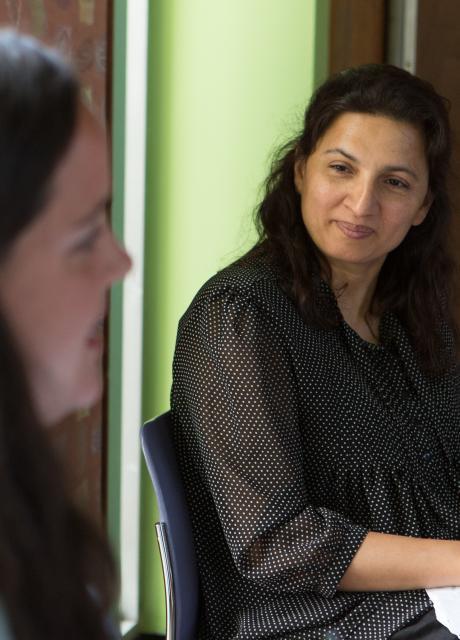
6 Critical Skills for Counselors

Janet Echelman ’97
Becoming a champion for the deaf community.
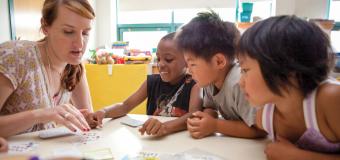
6 Ways Educators Can Prevent Bullying
Thank you for visiting nature.com. You are using a browser version with limited support for CSS. To obtain the best experience, we recommend you use a more up to date browser (or turn off compatibility mode in Internet Explorer). In the meantime, to ensure continued support, we are displaying the site without styles and JavaScript.
- View all journals
Empathy articles from across Nature Portfolio
Empathy is a social process by which a person has an understanding and awareness of another's emotions and/or behaviour, and can often lead to a person experiencing the same emotions. It differs from sympathy, which involves concern for others without sharing the same emotions as them.
Latest Research and Reviews
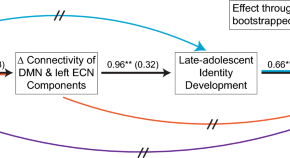
Diverse adolescents’ transcendent thinking predicts young adult psychosocial outcomes via brain network development
- Rebecca J. M. Gotlieb
- Xiao-Fei Yang
- Mary Helen Immordino-Yang
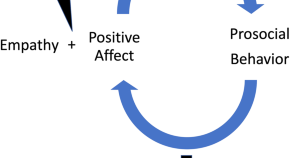
The effect of psilocybin on empathy and prosocial behavior: a proposed mechanism for enduring antidepressant effects
- Kush V. Bhatt
- Cory R. Weissman
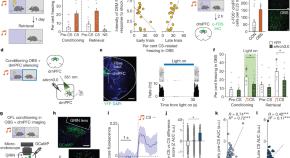
A distinct cortical code for socially learned threat
Studies in mice show that observational fear learning is encoded by neurons in the dorsomedial prefrontal cortex in a manner that is distinct from the encoding of fear learned by direct experience.
- Shana E. Silverstein
- Ruairi O’Sullivan
- Andrew Holmes
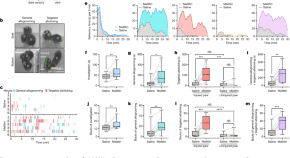
Cortical regulation of helping behaviour towards others in pain
A study describes the role of the anterior cingulate cortex in coding and regulating helping behaviour exhibited by mice towards others experiencing pain.
- Mingmin Zhang
- Ye Emily Wu
- Weizhe Hong
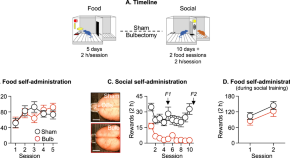
Social odor choice buffers drug craving
- Kimberly M. Papastrat
- Cody A. Lis
- Marco Venniro
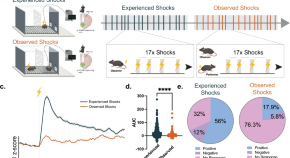
Nucleus accumbens core single cell ensembles bidirectionally respond to experienced versus observed aversive events
- Oyku Dinckol
- Noah Harris Wenger
- Munir Gunes Kutlu
News and Comment
Natural primate neurobiology.
A new study captures nearly the full repertoire of primate natural behaviour and reveals that highly distributed cortical activity maintains multifaceted dynamic social relationships.
- Jake Rogers
Your pain in my brain
- Helena Hartmann
Comforting in mice
- Sachin Ranade

Feeling another’s pain
Projections from the anterior cingulate cortex to the nucleus accumbens are required for the social transfer of pain or analgesia in mice.
- Darran Yates
Taking action: empathy and social interaction in rats
- Sam A. Golden
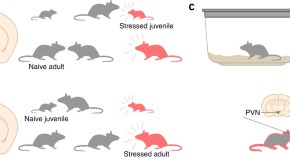
Stress and sociability
Humans and animals can react to the affective state of others in distress. However, exposure to a stressed partner can trigger stress-related adaptations. Two studies shed light on the mechanisms underlying the behavioral responses toward stressed individuals and on the synaptic changes associated with social transmission of stress.
- Dana Rubi Levy
- Ofer Yizhar
Quick links
- Explore articles by subject
- Guide to authors
- Editorial policies

Reviewed by Psychology Today Staff
Empathy is the ability to recognize, understand, and share the thoughts and feelings of another person, animal, or fictional character. Developing empathy is crucial for establishing relationships and behaving compassionately. It involves experiencing another person’s point of view, rather than just one’s own, and enables prosocial or helping behaviors that come from within, rather than being forced.
Some surveys indicate that empathy is on the decline in the United States and elsewhere, findings that motivate parents, schools, and communities to support programs that help people of all ages enhance and maintain their ability to walk in each other’s shoes.
- Developing Empathy
- Empathy in Relationships
- The Downside of Empathy

Empathy helps us cooperate with others, build friendships, make moral decisions, and intervene when we see others being bullied. Humans begin to show signs of empathy in infancy and the trait develops steadily through childhood and adolescence . Still, most people are likely to feel greater empathy for people like themselves and may feel less empathy for those outside their family, community, ethnicity , or race.
Empathy helps us connect and help others, but like other traits, it may have evolved with a selfish motive: using others as a “social antenna” to help detect danger. From an evolutionary perspective, creating a mental model of another person's intent is critical: the arrival of an interloper, for example, could be deadly, so developing sensitivity to the signals of others could be life-saving.
Babies display an understanding that people’s actions are guided by intentions and are able to act on that understanding before they are 18 months old , including trying to comfort a parent. More advanced reasoning about other people’s thoughts develops by around age 5 or 6, and research shows that parents who promote and model empathy raise more empathetic children.
Empathy, sympathy, and compassion are often used interchangeably, but they are not the same . Sympathy is feeling of concern for someone else, and a desire that they become happier or better off, while empathy involves sharing the other person’s emotions. Compassion is an empathic understanding of a person's feelings accompanied by altruism , or a desire to act on that person's behalf.
Researchers believe people can choose to cultivate and prioritize empathy. People who spend more time with individuals different from themselves tend to adopt a more empathic outlook toward others. Other research finds that reading novels can help foster the ability to put ourselves in the minds of others. Meditation has also been shown to help cultivate brain states that increase empathy.
Some neuroscientists have advanced the concept of "mirror neurons” as a possible source of empathy . These neurons, it is theorized, enhance the capacity to display, read, and mimic emotional signals through facial expressions and other forms of body language , enhancing empathy. But whether mirror neurons actually operate this way in humans is a subject of longstanding scientific debate, and some scientists question their very existence.

The ability to convey support for a partner, relative, or friend is crucial to establishing positive relationships. Empathy enables us to establish rapport with another person , make them feel that they are being heard, and, through words and body language, mimic their emotions. Perspective-taking , or the empathic ability to assume the cognitive state of another person and see a problem through their eyes, can further cement a connection.
In healthy relationships, people expect their partners to empathize with them when they face hardship or personal struggles, but the ability to empathize with a partner in good times may be at least as important. In one study, displaying empathy for a partner’s positive emotions was five times more beneficial for relationship satisfaction than only empathizing with his or her negative emotions.
People high in narcissism, or who have narcissistic personality disorder , can exhibit empathy and even compassion. However, that ability only goes so far, as ultimately their own needs come first. Some researchers believe narcissists can develop greater empathy by developing greater self-compassion, which can increase their own feelings of security and self-worth and enable them to open up to hearing others.

Putting yourself in someone else’s shoes can be beneficial, but when it becomes one’s default mode of relating to others, it can blind an individual to their own needs and even make them vulnerable to those who would take advantage of them.
People who regularly put the feelings and perspectives of others above their own may experience feelings of emptiness or alienation and develop generalized anxiety or low-level depression . Psychopaths, on the other hand, are capable of empathic accuracy , or correctly inferring thoughts and feelings, but may have no experiential referent for it: a true psychopath does not feel empathy.
First responders, humanitarian aid workers, doctors, therapists, journalists, and others whose work involves opening themselves up to others’ pain tend to be highly empathic. However, they may come to share the heartbreak of those they help or whose stories they record. As such “emotional residue” accumulates, they may shut down , burn out , and become less willing or able to give of themselves.
Empaths are often characterized as being highly sensitive and overly focused on the needs of others. They may benefit from time alone, as they find it draining to be in the presence of other people. People who are very empathic are more likely to be targeted by manipulative individuals. For this reason, it is important to create healthy boundaries in all relationships, and to be cognizant of relationships with "energy vampires," who are draining to empaths and non-empaths alike.

It's dangerous to look at yourself through the narcissist’s distorted lens, but you may not realize it's skewed. It's like looking in a fun house mirror, not knowing it's warped.

There is more to good communication than using "I-statements," yet little has been written about other aspects of speaking that can help us get heard and connect.

Music with deep, reflective, romantic, and gentle attributes tends to enhance empathy.

When smart people looking at the same evidence disagree, the reason might be that they define basic concepts differently and talk past each other.

There’s a hunger for empathic leadership today in corporations, governments, medical centers, and small businesses across the globe.

Never underestimate the value of empathizing with your parents: The benefits could surprise you.

Have you ever wondered why people want to become philanthropists? What more is there to it than writing checks?

Learn 10 vital strategies for raising emotionally healthy children (as opposed to narcissists).

Persuasive presenters embrace and extend empathy to understand their audience and make choices about substance and style to create an audience-informed communication experience.

More books have been challenged in recent years than ever before. Here's how it may be impacting our mental health.
- Find a Therapist
- Find a Treatment Center
- Find a Psychiatrist
- Find a Support Group
- Find Online Therapy
- United States
- Brooklyn, NY
- Chicago, IL
- Houston, TX
- Los Angeles, CA
- New York, NY
- Portland, OR
- San Diego, CA
- San Francisco, CA
- Seattle, WA
- Washington, DC
- Asperger's
- Bipolar Disorder
- Chronic Pain
- Eating Disorders
- Passive Aggression
- Personality
- Goal Setting
- Positive Psychology
- Stopping Smoking
- Low Sexual Desire
- Relationships
- Child Development
- Self Tests NEW
- Therapy Center
- Diagnosis Dictionary
- Types of Therapy

At any moment, someone’s aggravating behavior or our own bad luck can set us off on an emotional spiral that threatens to derail our entire day. Here’s how we can face our triggers with less reactivity so that we can get on with our lives.
- Emotional Intelligence
- Gaslighting
- Affective Forecasting
- Neuroscience
Greater Good Science Center • Magazine • In Action • In Education
Empathy Defined
What is empathy.
The term “empathy” is used to describe a wide range of experiences. Emotion researchers generally define empathy as the ability to sense other people’s emotions, coupled with the ability to imagine what someone else might be thinking or feeling.
Contemporary researchers often differentiate between two types of empathy : “Affective empathy” refers to the sensations and feelings we get in response to others’ emotions; this can include mirroring what that person is feeling, or just feeling stressed when we detect another’s fear or anxiety. “Cognitive empathy,” sometimes called “perspective taking,” refers to our ability to identify and understand other people’s emotions. Studies suggest that people with autism spectrum disorders have a hard time empathizing .
Empathy seems to have deep roots in our brains and bodies, and in our evolutionary history . Elementary forms of empathy have been observed in our primate relatives , in dogs , and even in rats . Empathy has been associated with two different pathways in the brain, and scientists have speculated that some aspects of empathy can be traced to mirror neurons , cells in the brain that fire when we observe someone else perform an action in much the same way that they would fire if we performed that action ourselves. Research has also uncovered evidence of a genetic basis to empathy , though studies suggest that people can enhance (or restrict) their natural empathic abilities.
Having empathy doesn’t necessarily mean we’ll want to help someone in need, though it’s often a vital first step toward compassionate action.
For more: Read Frans de Waal’s essay on “ The Evolution of Empathy ” and Daniel Goleman’s overview of different forms of empathy , drawing on the work of Paul Ekman.
What are the Limitations?

When Empathy Hurts, Compassion Can Heal
A new neuroscientific study shows that compassion training can help us cope with other…

Does Empathy Reduce Prejudice—or Promote It?
Rodolfo Mendoza-Denton explains how to make sense of conflicting scientific evidence.

How to Avoid the Empathy Trap
Do you prioritize other people's feelings over your own? You might be falling into the…
Featured Articles

One Skill That Can Help Students Bridge Political Divides
Here's how one teacher has tried to help students envision better outcomes for everyone, a skill researchers call "moral imagination."

Who Finds Joy in Other People’s Joy?
Who feels good when a good thing happens for someone else? Our GGSC sympathetic joy quiz results suggest it has almost nothing to do with money or…


How Accurate Are Media Portrayals of Foster Families?
Movies and TV often paint the youth foster system in a negative light. But do people who went through the system agree?

Can Artificial Intelligence Help Human Mental Health?
A conversation with UC Berkeley School of Public Health professor Jodi Halpern about AI ethics, empathy, and mental health.

The Best Greater Good Articles of 2023
We round up the most-read and highly rated Greater Good articles from the past year.
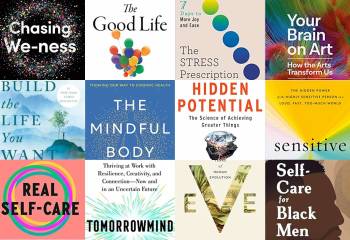
Our Favorite Books of 2023
Greater Good’s editors pick the most thought-provoking, practical, and inspirational science books of the year.
Why Practice It?
Empathy is a building block of morality—for people to follow the Golden Rule, it helps if they can put themselves in someone else’s shoes. It is also a key ingredient of successful relationships because it helps us understand the perspectives, needs, and intentions of others. Here are some of the ways that research has testified to the far-reaching importance of empathy.
- Seminal studies by Daniel Batson and Nancy Eisenberg have shown that people higher in empathy are more likely to help others in need, even when doing so cuts against their self-interest .
- Empathy is contagious : When group norms encourage empathy, people are more likely to be empathic—and more altruistic.
- Empathy reduces prejudice and racism : In one study, white participants made to empathize with an African American man demonstrated less racial bias afterward.
- Empathy is good for your marriage : Research suggests being able to understand your partner’s emotions deepens intimacy and boosts relationship satisfaction ; it’s also fundamental to resolving conflicts. (The GGSC’s Christine Carter has written about effective strategies for developing and expressing empathy in relationships .)
- Empathy reduces bullying: Studies of Mary Gordon’s innovative Roots of Empathy program have found that it decreases bullying and aggression among kids, and makes them kinder and more inclusive toward their peers. An unrelated study found that bullies lack “affective empathy” but not cognitive empathy, suggesting that they know how their victims feel but lack the kind of empathy that would deter them from hurting others.
- Empathy reduces suspensions : In one study, students of teachers who participated in an empathy training program were half as likely to be suspended, compared to students of teachers who didn’t participate.
- Empathy promotes heroic acts: A seminal study by Samuel and Pearl Oliner found that people who rescued Jews during the Holocaust had been encouraged at a young age to take the perspectives of others.
- Empathy fights inequality. As Robert Reich and Arlie Hochschild have argued, empathy encourages us to reach out and want to help people who are not in our social group, even those who belong to stigmatized groups , like the poor. Conversely, research suggests that inequality can reduce empathy : People show less empathy when they attain higher socioeconomic status.
- Empathy is good for the office: Managers who demonstrate empathy have employees who are sick less often and report greater happiness.
- Empathy is good for health care: A large-scale study found that doctors high in empathy have patients who enjoy better health ; other research suggests training doctors to be more empathic improves patient satisfaction and the doctors’ own emotional well-being .
- Empathy is good for police: Research suggests that empathy can help police officers increase their confidence in handling crises, diffuse crises with less physical force, and feel less distant from the people they’re dealing with.
For more: Learn about why we should teach empathy to preschoolers .
How Do I Cultivate It?
Humans experience affective empathy from infancy, physically sensing their caregivers’ emotions and often mirroring those emotions. Cognitive empathy emerges later in development, around three to four years of age , roughly when children start to develop an elementary “ theory of mind ”—that is, the understanding that other people experience the world differently than they do.
From these early forms of empathy, research suggests we can develop more complex forms that go a long way toward improving our relationships and the world around us. Here are some specific, science-based activities for cultivating empathy from our site Greater Good in Action :
- Active listening: Express active interest in what the other person has to say and make him or her feel heard.
- Shared identity: Think of a person who seems to be very different from you, and then list what you have in common.
- Put a human face on suffering: When reading the news, look for profiles of specific individuals and try to imagine what their lives have been like.
- Eliciting altruism: Create reminders of connectedness.
And here are some of the keys that researchers have identified for nurturing empathy in ourselves and others:
- Focus your attention outwards: Being mindfully aware of your surroundings, especially the behaviors and expressions of other people , is crucial for empathy. Indeed, research suggests practicing mindfulness helps us take the perspectives of other people yet not feel overwhelmed when we encounter their negative emotions.
- Get out of your own head: Research shows we can increase our own level of empathy by actively imagining what someone else might be experiencing.
- Don’t jump to conclusions about others: We feel less empathy when we assume that people suffering are somehow getting what they deserve .
- Show empathic body language : Empathy is expressed not just by what we say, but by our facial expressions, posture, tone of voice, and eye contact (or lack thereof).
- Meditate: Neuroscience research by Richard Davidson and his colleagues suggests that meditation—specifically loving-kindness meditation, which focuses attention on concern for others—might increase the capacity for empathy among short-term and long-term meditators alike (though especially among long-time meditators).
- Explore imaginary worlds: Research by Keith Oatley and colleagues has found that people who read fiction are more attuned to others’ emotions and intentions.
- Join the band: Recent studies have shown that playing music together boosts empathy in kids.
- Play games : Neuroscience research suggests that when we compete against others, our brains are making a “ mental model ” of the other person’s thoughts and intentions.
- Take lessons from babies: Mary Gordon’s Roots of Empathy program is designed to boost empathy by bringing babies into classrooms, stimulating children’s basic instincts to resonate with others’ emotions.
- Combat inequality: Research has shown that attaining higher socioeconomic status diminishes empathy , perhaps because people of high SES have less of a need to connect with, rely on, or cooperate with others. As the gap widens between the haves and have-nots, we risk facing an empathy gap as well. This doesn’t mean money is evil, but if you have a lot of it, you might need to be more intentional about maintaining your own empathy toward others.
- Pay attention to faces: Pioneering research by Paul Ekman has found we can improve our ability to identify other people’s emotions by systematically studying facial expressions. Take our Emotional Intelligence Quiz for a primer, or check out Ekman’s F.A.C.E. program for more rigorous training.
- Believe that empathy can be learned : People who think their empathy levels are changeable put more effort into being empathic, listening to others, and helping, even when it’s challenging.
For more : The Ashoka Foundation’s Start Empathy initiative tracks educators’ best practices for teaching empathy . The initiative gave awards to 14 programs judged to do the best job at educating for empathy . The nonprofit Playworks also offers eight strategies for developing empathy in children .
What Are the Pitfalls and Limitations of Empathy?
According to research , we’re more likely to help a single sufferer than a large group of faceless victims, and we empathize more with in-group members than out-group members . Does this reflect a defect in empathy itself? Some critics believe so , while others argue that the real problem is how we suppress our own empathy .
Empathy, after all, can be painful. An “ empathy trap ” occurs when we’re so focused on feeling what others are feeling that we neglect our own emotions and needs—and other people can take advantage of this. Doctors and caregivers are at particular risk of feeling emotionally overwhelmed by empathy.
In other cases, empathy seems to be detrimental. Empathizing with out-groups can make us more reluctant to engage with them, if we imagine that they’ll be critical of us. Sociopaths could use cognitive empathy to help them exploit or even torture people.
Even if we are well-intentioned, we tend to overestimate our empathic skills. We may think we know the whole story about other people when we’re actually making biased judgments—which can lead to misunderstandings and exacerbate prejudice.
Rethink Your Research Practices To Create Inclusive Experiences
Senem Guler Biyikli , Analyst
More than 1 billion people worldwide have disabilities and are underserved by today’s digital products. Global Accessibility Awareness Day (GAAD), recognized yearly on May 16 , reminds us of this fact and aims to get everyone talking, thinking, and learning about digital access and inclusion.
By practicing inclusive design , businesses can increase revenue, decrease costs, improve resilience, and build trust with customers and employees. To practice inclusive design successfully, your research practices must also be inclusive. This is especially important for disability inclusion, because many companies are tempted to use quick-fix solutions to comply with digital accessibility requirements and skip research done with people with disabilities. According to a recent Forrester survey, only 29% of businesses in North America gather feedback from people with disabilities on their products.
On this Global Accessibility Awareness Day, take the opportunity to assess your research practices for inclusion . Here are three questions to start with.
1. Are You Including People With Disabilities In Your Research?
Conducting research with a diverse range of participants is essential for inclusive research practices, and this requires inclusive recruitment. You can reach diverse participants, including people with disabilities, by using inclusive screener questions . If you’re asking whether a participant has a disability, explain why you’re asking this question (e.g., “to better understand our customers”), and don’t forget to ask if they use any assistive technologies so that you can design your research study accordingly. For example, make sure the tools you use to run research, such as experience research platforms , are accessible. Some of our clients partner with organizations such as Fable and Knowbility for access to panels of people with disabilities for research.
Successful companies that are dedicated to inclusive design also monitor participant demographics to ensure that they are reaching a diverse group of participants. You can start doing this by auditing past studies to see who participated and who is missing in your research.
2. Are Your Empathy Practices Effective?
To build empathy with your customers , engage them throughout the design process — don’t just imagine what they might be going through. Empathy tools, such as personas and empathy maps, are great to understand customers, but without adequate research, these tools build on assumptions. This is why empathy workshops — where employees pretend to have a disability (e.g., wearing a blindfold) and use the company’s products as a way of understanding the experiences of customers with disabilities — don’t work. Participants walk away from those workshops with negative feelings , thinking it was hard, and don’t realize that it was just their own lack of experience in using assistive technologies. To understand experiences of customers with disabilities from their perspective, engage with them, observe their interactions with your product, and focus on solutions to improve their experiences.
3. Are You Incorporating Employee Feedback?
Employees know your company’s values, products, and customers, and their feedback is important to improve customer experience. Incorporating employee feedback to create accessible experiences not only improves your product but also shows that you recognize the value of employees’ thoughts. It also raises awareness by signaling that inclusion is a core value for your company. Seeking employee feedback, especially from those with disabilities, helps you identify accessibility issues early in the product development process. Employee resource groups are a great place to start. For example, Salesforce listens to and learn from its employees and employee resource groups to guide its inclusive product language.
Ready To Get Started? We Have Research To Help
For more research on this topic and examples of how to get started, check out the following Forrester reports:
- Global Accessibility Awareness Day 2024: The Business Case For Accessibility Grows Stronger (my colleague Gina Bhawalkar ’s GAAD blog)
- Build The Business Case For Inclusive Design
- Build A Toolkit To Assess Experiences For Inclusion
- Words Matter: Inclusive Experiences Start With Inclusive Language
- Five Best Practices To Design For Empathy In Digital Experiences
If you’re a Forrester client and would like to discuss this topic further, set up a conversation with me here . You can also follow or connect with me on LinkedIn if you’d like to engage there.
- Accessible Design
- Age of the Customer
- customer-centric design

Thanks for signing up.
Stay tuned for updates from the Forrester blogs.
CX Summit Is Coming To A City Near You!
Elevate your cx strategy and skills at forrester’s cx summits. meet analysts to gain insights, research, and frameworks for exceptional customer outcomes — and create boundless experiences with genai., global accessibility awareness day 2024: the business case for accessibility grows stronger, digital cx and design trends worth watching in 2024, get the insights at work newsletter, help us improve.
- Alzheimer's disease & dementia
- Arthritis & Rheumatism
- Attention deficit disorders
- Autism spectrum disorders
- Biomedical technology
- Diseases, Conditions, Syndromes
- Endocrinology & Metabolism
- Gastroenterology
- Gerontology & Geriatrics
- Health informatics
- Inflammatory disorders
- Medical economics
- Medical research
- Medications
- Neuroscience
- Obstetrics & gynaecology
- Oncology & Cancer
- Ophthalmology
- Overweight & Obesity
- Parkinson's & Movement disorders
- Psychology & Psychiatry
- Radiology & Imaging
- Sleep disorders
- Sports medicine & Kinesiology
- Vaccination
- Breast cancer
- Cardiovascular disease
- Chronic obstructive pulmonary disease
- Colon cancer
- Coronary artery disease
- Heart attack
- Heart disease
- High blood pressure
- Kidney disease
- Lung cancer
- Multiple sclerosis
- Myocardial infarction
- Ovarian cancer
- Post traumatic stress disorder
- Rheumatoid arthritis
- Schizophrenia
- Skin cancer
- Type 2 diabetes
- Full List »
share this!
May 17, 2024
This article has been reviewed according to Science X's editorial process and policies . Editors have highlighted the following attributes while ensuring the content's credibility:
fact-checked
peer-reviewed publication
trusted source
Autistic people's feelings mostly misread—empathy works both ways, research reveals
by Brunel University
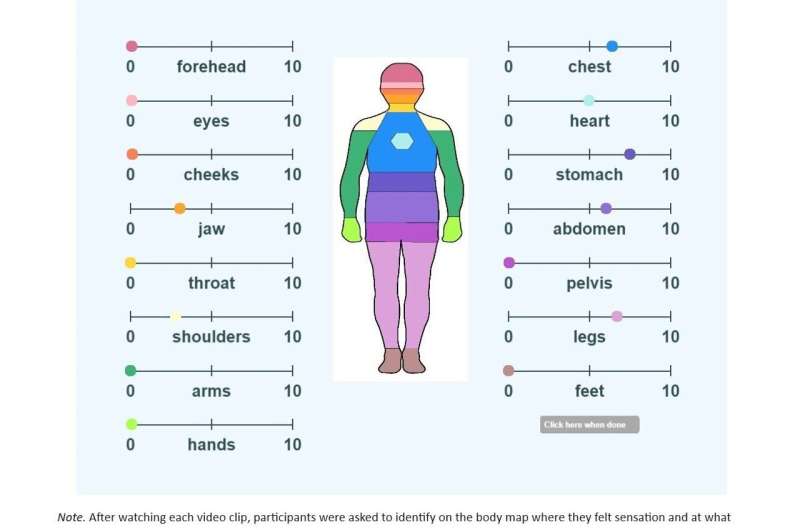
The idea that autistic people lack empathy is simply short-sighted and non-autistic people may find it just as hard to put themselves in someone else's shoes, a study suggests.
A paper in the journal Autism flips the script on the often-said stereotype that autistic people have difficulty imagining how others feel.
Participants shown video clips featuring autistic and non-autistic people retelling emotional events revealed people without autism find it significantly harder to track autistic people's emotions.
It also revealed people felt emotions more intensely in the body when seeing clips of autistic people compared with non-autistic people. This was magnified when they talked about anger and fear.
It has strong implications for social and therapeutic relationships with autistic people, said autistic researcher Rachael Cheang at Brunel University London's Centre for Cognitive Neuroscience.
"There's always this feeling that people with autism lack empathy . That's usually what you hear, but these results are quite shocking because they're contrary to how we normally think of it."
This is the first experimental evidence to show that rather than lacking empathy, autistic people instead see the world differently and non-autistic people struggle to understand their emotions just as much as the reverse. Called "the double empathy problem," this theory by Dr. Damian Milton emerged in the early 2010s. An idea many autistic people agreed with, but until now hasn't been shown by science.
"This impacts how autistic people are viewed," said Mrs. Cheang. If they're feeling happy about something and nobody's recognizing that, people won't celebrate the joy with them. And if they're feeling sad about something, it's not recognized that that person might be upset or sad about something. So, then they'll be lacking support or commiseration from people around them."
Cognitive psychologists measured autistic traits of 81 participants asked to rate emotions—happy, sad, anger and fear in video clips of people across the spectrum talking about their emotional experiences. In a separate task, they were asked to identify the emotions of people in the videos, gauge their intensity and place them on a body map. They were all kept in the dark about the diagnosis of the people shown.
Autistic people are at a higher risk of suicide than non-autistic people. Between 11 and 66% of autistic adults think about suicide during their lifetime, and up to 35% plan or attempt it according to figures from 2020. Mrs. Cheang says, "Obviously, I'm wondering now, if part of that is being driven by the fact that nobody's understanding them, empathizing with them, you know, feeling what they're feeling."
"The implications are wide," said research group leader, Dr. Ignazio Puzzo. "It's important for caregivers, people working in education, therapists, doctors, hospital staff , doctors to be aware of these differences and focus on improving understanding or noticing how an autistic person is feeling to help alleviate their struggles and improve their well-being."
Explore further
Feedback to editors

New analysis estimates the effects of race-neutral lung function testing on patients, hospitals, and beyond
5 hours ago

World-first trial shows benefits of finding and treating undiagnosed asthma and COPD
8 hours ago

Acetaminophen shows promise in warding off acute respiratory distress syndrome, organ injury in patients with sepsis
12 hours ago

Modular communicative leadless ICD found to be safe and exceeds performance expectations
May 18, 2024

Creativity and humor shown to promote well-being in older adults via similar mechanisms

Sweet taste receptor affects how glucose is handled metabolically by humans

Better medical record-keeping needed to fight antibiotic overuse, studies suggest

Repeat COVID-19 vaccinations elicit antibodies that neutralize variants, other viruses

A long-term ketogenic diet accumulates aged cells in normal tissues, new study shows

Gut bacteria enhance cancer immunotherapy in mouse study
Related stories.

Largest ever study of autistic people's research priorities finds need for focus on mental health
Feb 9, 2024

Autistic people find it harder to identify anger in facial expressions, new study shows
Jun 2, 2021

Autistic people are more likely to experience depression and anxiety during pregnancy
Oct 26, 2022

New research shows that autistic people are better at reading emotions in cartoons
Aug 4, 2022

Study suggests early self-awareness of autism leads to better quality of life
Apr 26, 2022

Creating social access for autistic children, what does it take?
Nov 10, 2021
Recommended for you

Simple learning test may be used to diagnose autism at just six months of age
May 16, 2024

Metabolism of autism reveals developmental origins
May 10, 2024

Autism's missing microbes may influence social behavior by protecting the gut

Study identifies primary cause of sensory hypersensitivity in a mouse model of autism spectrum disorder
May 9, 2024

Potential link between PTSD and autism found in mice
May 8, 2024

Gene linked to epilepsy and autism decoded in new study
Apr 26, 2024
Let us know if there is a problem with our content
Use this form if you have come across a typo, inaccuracy or would like to send an edit request for the content on this page. For general inquiries, please use our contact form . For general feedback, use the public comments section below (please adhere to guidelines ).
Please select the most appropriate category to facilitate processing of your request
Thank you for taking time to provide your feedback to the editors.
Your feedback is important to us. However, we do not guarantee individual replies due to the high volume of messages.
E-mail the story
Your email address is used only to let the recipient know who sent the email. Neither your address nor the recipient's address will be used for any other purpose. The information you enter will appear in your e-mail message and is not retained by Medical Xpress in any form.
Newsletter sign up
Get weekly and/or daily updates delivered to your inbox. You can unsubscribe at any time and we'll never share your details to third parties.
More information Privacy policy
Donate and enjoy an ad-free experience
We keep our content available to everyone. Consider supporting Science X's mission by getting a premium account.
E-mail newsletter
An official website of the United States government
The .gov means it’s official. Federal government websites often end in .gov or .mil. Before sharing sensitive information, make sure you’re on a federal government site.
The site is secure. The https:// ensures that you are connecting to the official website and that any information you provide is encrypted and transmitted securely.
- Publications
- Account settings
Preview improvements coming to the PMC website in October 2024. Learn More or Try it out now .
- Advanced Search
- Journal List
- Healthcare (Basel)

The Role of Empathy in Health and Social Care Professionals
Maria moudatsou.
1 Department of Social Work, Hellenic Mediterranean University, 71410 Heraklion, Greece; rg.oohay@muostaduom
2 Laboratory of Interdisciplinary Approaches for the Enhancement of Quality of Life (Quality of Life Lab), Hellenic Mediterranean University, 71410 Heraklion, Greece; moc.liamg@uoluoporvatsitera
3 Centre of Mental Health, 71201 Heraklion, Greece
Areti Stavropoulou
4 Nursing Department, University of West Attica, 12243 Athens, Greece
Anastas Philalithis
5 Department of Social Medicine, Medical School, University of Crete, 70013 Heraklion, Greece; rg.cou@lalihp
Sofia Koukouli
The current article is an integrative and analytical literature review on the concept and meaning of empathy in health and social care professionals. Empathy, i.e., the ability to understand the personal experience of the patient without bonding with them, constitutes an important communication skill for a health professional, one that includes three dimensions: the emotional, cognitive, and behavioral. It has been proven that health professionals with high levels of empathy operate more efficiently as to the fulfillment of their role in eliciting therapeutic change. The empathetic professional comprehends the needs of the health care users, as the latter feel safe to express the thoughts and problems that concern them. Although the importance of empathy is undeniable, a significantly high percentage of health professionals seem to find it difficult to adopt a model of empathetic communication in their everyday practice. Some of the factors that negatively influence the development of empathy are the high number of patients that professionals have to manage, the lack of adequate time, the focus on therapy within the existing academic culture, but also the lack of education in empathy. Developing empathetic skills should not only be the underlying objective in the teaching process of health and social care undergraduate students, but also the subject of the lifelong and continuous education of professionals.
1. Introduction
Communication skills have been described as the most important ability for a health professional. Efficient communication depends upon the therapist feeling certain that they have really heard and recorded the health care user’s needs so as to provide personalized care [ 1 ]. It is important for health professionals to understand people’s feelings, opinions and experiences in order to assess their real needs and act accordingly, offering tailor-made services. Reaching that goal makes the development of empathetic skills necessary [ 2 ].
The concept of empathy is a common denominator for many health professionals such as nurses, doctors, psychologists, and social workers [ 3 , 4 , 5 , 6 ]. The person-centered approach for the unconditional acceptance of the health care user and empathy have for years been the fundamental values in the education and implementation of clinical social practice [ 3 , 7 , 8 , 9 ].
2. Material and Methods
The aim of the present paper was to analyze the concept of empathy and emphasize its importance to the health professions. The research questions under consideration have been the following: 1. What does empathy mean and which are its dimensions; 2. What are the role and meaning of empathy in health and social care professions for the therapeutic journey of the health care user; 3. How can we assess the levels of empathy in professionals (assessment tools); 4. Which factors influence empathy?
A literature search was conducted by searching PubMed and Scopus databases, to identify studies of the last fifteen years published in English and Greek language. The key-words used were ‘empathy’ and ‘health professionals’. Out of the search, 78 studies were identified that better answer the aim and purposes of the present paper. These studies were discussed and evaluated by the authoring team in order to reach consensus on the eligibility of each one with the proposed research questions. After agreement was reached, re-examination and analysis of the studies’ findings lead to the formulation of four thematic categories, namely, a) Concept definition and dimensions, b) The role of empathy in health and social care professionals, c) Assessing empathy, and d) Factors that influence empathy.
3.1. Concept Definition and Dimensions
Empathy is the ability to understand and share other people’s feelings [ 10 ]. It is a core concept as, according to the psychodynamic, behavioral and person-centered approaches, it facilitates the development of a therapeutic relationship with the health care user, providing the basis for therapeutic change [ 11 ].
Empathy was first mentioned in a psychotherapeutic context in the 1950s [ 7 ]. The person-centered approach defined it as the temporary condition that a health professional experiences in his/her effort to understand a health care user’s life without bonding with them [ 3 , 12 ].
The contemporary concept of empathy is multidimensional and consists of affective, cognitive, and behavioral aspects [ 6 , 11 , 13 ]. Throughout history, the development and integration of this concept evolved along three different time periods. Until the end of the 1950s, the cognitive dimension was mostly prevalent. From 1960 onwards, emphasis was given to the affective dimension, whereas since 1970, empathy has been defined in all its multi-dimensionality; that is, the behavioral aspect has been added to the everyday practice of the health care professionals [ 14 ].
The affective dimension consists of the concepts of caring and that of the sincere, unconditional acceptance of the health care user (congruence) [ 8 , 15 , 16 ]. Caring refers to the assistance and support as byproducts of an emotional interaction. The concept of the full and sincere unconditional acceptance refers to the approval of the ‘other’ and a consensus between people, without preconceptions or stereotypes.
The cognitive dimension pertains to the interpersonal sensitivity and the ability to understand the position the other person is in (perspective taking) [ 17 , 18 ]. Interpersonal sensitivity means objectively understanding the other person’s situation. It is a deep process of getting to know someone, based in both verbal and non-verbal cues. The ability to understand the other person’s situation refers to the flexibility and the objective understanding of the point of view of the other person (walk in their shoes, comprehending the way they perform cognitively, emotionally, and mentally) [ 17 , 18 ].
Altruism and the therapeutic relationship both belong to the behavioral dimension which develops empathy into practice [ 19 , 20 ]. Altruism is a socially directed behavior aimed at relieving difficulties, problems, and the pain associated with them [ 11 ].
Sympathy, empathy, and compassion are closely related terms that are often used interchangeably. Sympathy has been defined as an emotional reaction of pity toward the misfortune of another, especially those who are perceived as suffering unfairly [ 21 ]. Empathy is understood as a more complex interpersonal construct that involves awareness and intuition, while compassion is a ‘complementary social emotion, elicited by witnessing the suffering of others’ and is related with the feelings of concern, warmth associated to motivating of support [ 22 ]. Empathetic listening might result in compassion fatigue because of prolonged exposure to stress and all it evokes [ 23 ]. Self-care practice, well-being, and self-awareness are fundamental in enhancing empathy and reducing compassion fatigue [ 23 , 24 ].
3.2. The Role of Empathy in Health and Social Care Professionals
In a qualitative research study, nurse students, who were asked their opinion on empathy, emphasized the three dimensions of the concept [ 3 ]. Participants described it as the nurse’s ability to understand and experience other people’s feelings, thoughts, and wishes, as well as the nurse’s capacity to comprehend the emotional and cognitive state of the person they work with. To sum up, empathy is perceived as a combination of the emotional, cognitive and practical skills involved when caring for a patient [ 3 ].
Empathy is one of the fundamental tools of the therapeutic relationship between the carers and their patients and it has been proven that its contribution is vital to better health outcomes [ 8 , 25 , 26 ]. As it allows the health care providers to detect and recognize the users’ experiences, worries, and perspectives [ 27 ], it strengthens the development and improvement of the therapeutic relationship between the two parts [ 28 ]. It is widely acknowledged that the health professional’s empathetic ability leads to better therapeutic results [ 29 ].
The empathetic relationship of the health professionals with their health care users reinforces their cooperation towards designing a therapeutic plan and a tailor-made intervention, increasing thus the patient’s satisfaction from the therapeutic process. This way, quality of care is enhanced, errors are eliminated, and an increased percentage of health care recipients positively experience therapy [ 30 , 31 , 32 , 33 , 34 ]. Furthermore, it has been noted that the empathetic relationship developed during the process of care reinforces the therapeutic results, as the users better comply with the therapeutic course of action [ 34 ].
Studies performed in various groups of patients with different health problems generated positive results regarding the progress of their health. Specifically, studies of patients with diabetes showed that there is an association between empathy and the positive therapeutic course of disease [ 31 , 35 ]. Moreover, patients with cancer demonstrate less stress, depression, and aggressiveness when receiving empathetic nursing care [ 36 ]. The empathetic relationship between a midwife and a future mother increases the latter’s satisfaction and lessens the stress, the agony, and the pain of the forthcoming labor as the mother feels security, trust, and encouragement [ 37 ].
Understanding based on empathy is critical to the relationship between the health professional and the recipient of care. When that happens, health care users feel secure and trust the professional’s abilities. Therefore, the distance between the expert and the patient shortens and both of them come closer, enjoying mutual benefits [ 12 ]. Moreover, a relationship based on empathy helps the therapists lessen their stress and burnout in the workplace and adds to their quality of life [ 37 , 38 ]. It has been shown that physicians who have higher levels of empathy experience less burnout or depression [ 39 , 40 ].
Empathy is especially important to the social care professions. It has been noted that the ability of the social worker for empathy and understanding of the users’ experiences and feelings plays a crucial role in social care as empathy is one of the most important skills that these professionals may employ to develop a therapeutic relationship [ 5 , 41 ].
Health care users who experience empathy during their treatment exhibit better results and a higher possibility for a potential improvement [ 42 ]. Moreover, social workers with higher levels of empathy work more efficiently and productively as to the fulfillment of their role in creating social change [ 13 ]. This happens because empathy helps the social worker understand and feel compassion towards their health care users so as the latter can feel secure to express their thoughts and problems. This way, a basis for trust is created, one that leads to therapeutic change and the improvement of the care recipient’s overall social functionality [ 13 ]. Social functionality levels are assessed by the social worker and refer to the ability of a person to accomplish their everyday activities (preparing and keeping meals, seeking accommodation, taking care of their selves, commuting) as well as their ability to fulfill social roles (parent, employee, member of a community) according to the requirements of their cultural environment [ 43 ].
Empathy contributes to the precise assessment of the situation the health care user is in. It offers the therapists the chance to make good use of non-verbal cues (behavior modeling, body movements, tone of voice, etc.) and helps them manage the user’s emotions. What is more, empathy enhances the user’s ability to comprehend reality and improve the quality of their life [ 13 ].
3.3. Assessing Empathy
Although both health care users and health professionals consider empathy as very important for the development of the therapeutic relationship and a necessary skill for a therapist, studies show a reduction of empathy in professional relationships. Often, health care users believe that health professionals do not understand the situation that health care users are in, whereas research findings showed that health professionals and health care users have different views on the communication abilities of the former, as if they come from different worlds [ 44 , 45 ]. It is especially important that—according to research findings deriving from medical student samples—empathy seems to increase in the first year of studies, but starts decreasing around the third year and remains low up to graduation [ 46 , 47 ].
As mentioned before, there are different dimensions, but also levels of empathy. Accordingly, there are different assessment scales for professionals and patient-users [ 48 ].
One of the most important tools for the quantitative assessment of empathy is the Jefferson Scale of Empathy (JSE) which was originally used to evaluate empathy in medical students [ 27 , 49 ]. Subsequently, its use was extended to other professional groups also, for example physicians, health professionals in general and students of other health professions [ 27 , 49 , 50 , 51 ]. The Jefferson scale has been used in many countries, such as the USA, Poland, Korea, Italy, Japan and has been standardized for its validity and reliability [ 12 , 49 , 50 , 52 , 53 ]. It is self-administered and completed by physicians and other health professionals who provide care to patients in clinical settings. Moreover, students of medical, nursing, and other health care sciences may also complete it. The scale includes 20 questions and the overall score ranges from twenty to one hundred and forty; higher scores indicate a better empathic relationship in the medical and therapeutic care [ 26 , 49 , 53 , 54 ].
More specifically, for social work, the Empathy Scale for Social Workers (ESSW) is a questionnaire designed for the quantitative assessment of empathy in social care professionals and students. It can be very useful in practice settings to support decision making processes, assist career choice decisions, continuing education, and supervision needs in the field of social care. Its usefulness is also underscored for potential social work supervisors, as it helps identifying the types of empathy needed while supervising clinicians and staff. The scale is a screening and self-evaluation tool completed by social work students and practitioners [ 13 ]. It consists of 41 questions and every question is marked on a five point scale and higher scores indicate higher levels of empathy [ 13 ].
3.4. Factors that Influence Empathy
As mentioned before, although research has showed the value of empathy, there are still many difficulties in regards to its implementation in the clinical practice [ 32 ]. A relatively high percentage of health professionals, about 70%, find it difficult to develop empathy with their health care users [ 32 ].
Age, self-reflection, appraisal, and emotions’ expressions were associated with women’s social workers empathy. Social workers had a higher score of empathy whenever they had previous work experience [ 55 ]. Additionally, there are studies that support that being female is associated with higher levels of empathy [ 56 , 57 ].
Research outcomes suggest that protective factors of social workers’ empathy are prosocial behavior toward work and positive personal and environmental resources [ 58 ]. Self-esteem, work engagement, and emotional regulation are also positively associated with empathy [ 58 , 59 ]. On the other hand, empathy is limited due to daily stress, that is a risk factor for burnout and compassion fatigue [ 59 , 60 ].
Empathy is positively correlated with reflective ability and emotional intelligence both in professional social workers and social work students [ 55 , 61 ]. According to a study in social work students in India, empathy and emotional intelligence were extracted as predictors of resilience through regression analysis. The authors underlined the need to enhance these attributes in social work students through the provision of appropriate curricular experiences [ 62 ].
The lack of empathy—or the low empathy levels—depends on several reasons. The most important are the large number of health care users that professionals have to deal with, the lack of adequate time, the focus on therapy, the predominant culture in medical schools, and the lack of training in empathy [ 30 ].
Further reasons include presumptions, a sense of superiority from the health professionals, and a fear of boundary violation. Time pressure, anxiety, a lack of self-awareness, and a lack of appropriate training, as well as the different socio-economic status, all the above do not favor empathy either [ 13 ].
According to scientific views from the Medicine field, empathy can be learned and Medical schools should educate their students in this respect [ 63 , 64 ]. Many studies have pointed out the necessity for future professionals to receive training in order to enhance their empathetic skills [ 64 , 65 ].
Although empathy is a core, quality principle for the health care professions, there are studies that show that health professionals cannot adequately express it and implement it [ 66 , 67 ]. According to studies in undergraduate nursing students, empirical education through learning processes can positively influence empathy [ 4 , 68 ]. Education is considered, both by students and professionals, as especially important for the reinforcement of empathetic skills [ 4 , 69 , 70 ].
Nevertheless, research data on the effectiveness of education in empathy are limited [ 71 , 72 , 73 ]. In a research study, conducted in the USA regarding the effect that empathy education has on health professionals, it was found that education contributes a great deal to the improvement of the therapeutic relationship [ 32 ]. In the same study, trained professionals are more likely to detect the emotion and progress of their health care users and therefore further explore and meet their needs. Education can be offered through hands-on work, multimedia use, role play, and experiential learning [ 32 ].
In a qualitative study, health professionals made suggestions regarding the enhancement of empathy. These suggestions included more holistic, educational interventions in behaviors that are central to the patient’s needs, with an emphasis on personal development, professional training, and supervision programs, rather than education in behavioral and communication skills [ 74 ].
‘Diversity Dolls’ is a hands-on educational method for the reinforcement of empathy that is used among social care students in a Greek university, so that students can instill empathetic skills in socially vulnerable populations [ 75 ]. It is believed that the use of such based-on-art methods helps social care students to feel safe, to explore, and give meaning to the real circumstances people live in, through pleasant, participatory, interactive activities [ 76 ].
Globally, creative educational methods such as journaling, art, role-play, and simulation games globally are becoming more popular in the health and social care fields helping students to increase their knowledge and skills in relation to empathy [ 75 , 76 ].
Teaching techniques and classroom methodologies familiarize social workers to empathetic skills [ 55 ]. In a study, among social work students, the results suggest that empathetic modeling from professors and field supervisors enhance social work students’ empathy. Social work educators should not focus on traditional teaching but they ought to concentrate on interactive and creative education that enhances the empathetic modeling and relationship between educators and students [ 77 ]. Apart from teaching social work students with mental flexibility, regulation of emotional and perspective taking, social workers should be taught empathy throughout the phenomenological psychological approach (seminars that utilize transcribed audio recordings of interactions) [ 78 , 79 ]. Additionally, regular supervision has a key role in enabling social workers to process their own feelings and to deal with empathy [ 80 ].
4. Conclusions
Empathy among health care users and professionals significantly contributes to how both groups behave as well as to their therapy and overall well-being. The development of empathetic skills constitutes an important priority in the education of health and social care students and should be encouraged. Educational programs should primarily be performed in a hands-on way that will strengthen the students’ personal and social skills and allow them to effectively communicate with their patients.
Moreover, health care professionals should be supported through continuous and personal development education programs as well as through supervision sessions that will allow them to develop empathetic skills. Political will is a prerequisite for the financing and encouragement of further actions.
Author Contributions
All authors have read and agreed to the published version of the manuscript.
This research received no external funding.
Conflicts of Interest
The authors declare no conflict of interest.
18 episodes
Is your digital products confusing users? This podcast series is your one-stop shop for conquering usability challenges! Join us as we delve into the world of user-centered design, exploring the entire usability testing process from start to finish. We'll uncover how to understand user needs, plan effective tests, analyse results, and leverage insights to create products users love. This podcast caters to all experience levels, offering user research techniques and ethical considerations. Learn how the think-aloud method can supercharge your usability testing for a stellar user experience.
xploreUX Cast Obruche Orugbo, PhD
- MAY 19, 2024
Contextual Inquiry - Diving Deep into User Needs
Listen to the xploreUX Cast and discover how Contextual Inquiry can transform your understanding of user needs. In this episode of xploreUX Cast, we unlock the secrets of Contextual Inquiry, a powerful user research technique for UX designers. Go beyond surveys and interviews! Learn how to observe users in their natural environment to uncover hidden needs and design experiences that truly resonate. You'll discover: What is Contextual Inquiry and Why It Matters How to Conduct Contextual Inquiry Sessions (Step-by-Step) Unveil Unspoken Needs & Build Deeper User Understanding Craft User-Centered Designs Through Empathy Bonus: Go Beyond the Basics with Multi-Method Research & Storytelling Plus: Ethical Considerations for Responsible Research Tips to Get Started and Overcome Challenges. If you're a UX designer, product manager, or anyone who wants to create products that resonate with users, this episode is for you! Listen, subscribe, and leave a review to join the xploreUX conversation! Share your experiences with Contextual Inquiry and let's keep learning from each other. Contextual Inquiry, User Research, UX Design, User Needs, Empathy, Storytelling Ready to dominate rapid UX research? Hit play! SUBSCRIBE TO OUR NEWSLETTER xploreUX Newsletter G E T I N T O U C H [email protected] For more tips check out our website xploreUX, See how we create delightful product experience from our list of services. --- Send in a voice message: https://podcasters.spotify.com/pod/show/obruche/message
- MAY 14, 2024
The Psychology of Usability - Understanding User Needs
xploreUX Podcast: The Psychology of Usability - Understanding User Needs Do you ever wonder why some apps are just so easy and enjoyable to use, while others leave you feeling frustrated and confused? The answer lies in the fascinating world of usability psychology! This episode of xploreUX dives deep into the minds of users, exploring the hidden desires, emotions, and thought patterns that shape our interactions with technology. In this episode, you'll learn: By understanding the psychology of usability, you can design experiences that are not only functional but also delightful to use. Tune in and discover how to create user journeys that resonate, engage, and keep people coming back for more! UX design, usability psychology, user experience, cognitive biases, user needs, Maslow's Hierarchy of Motivation SUBSCRIBE TO OUR NEWSLETTER xploreUX Newsletter G E T I N T O U C H Connect on X @xploreuxcast [email protected] For more tips check out our website xploreUX, See how we create delightful product experience from our list of services. --- Send in a voice message: https://podcasters.spotify.com/pod/show/obruche/message
- MAY 5, 2024
The UX Landscape - Navigating Usability Challenges
The User Experience Landscape: Navigating Usability Challenges Feeling lost in the ever-changing world of UX? This episode of xploreUX dives into the exciting yet challenging world of User Experience (UX) design. I explores the key challenges UX professionals face today, from keeping up with mobile-first design to navigating the tightrope between personalization and data privacy. I also explore strategies to overcome these challenges and design user experiences that are delightful and successful. Join us as we discuss: The evolving user and their ever-growing expectations Designing for mobile-first dominance Balancing personalization with user privacy concerns Adapting to new technologies like AR/VR The undervalued UX: How to advocate for user-centered design This episode is packed with actionable insights to help you navigate the UX landscape and design experiences that win. SUBSCRIBE TO OUR NEWSLETTER xploreUX Newsletter G E T I N T O U C H [email protected] On X @xploreuxcast For more tips check out our website xploreUX, See how we create delightful product experience from our list of services. --- Send in a voice message: https://podcasters.spotify.com/pod/show/obruche/message
- APR 29, 2024
Empathy in Design: Connecting with User Usability Needs
Empathy in Design: Connecting with User Usability Needs Ever wondered what empathy really means in design? This episode dives into how understanding your users leads to better products Join me, Obruche your host of xploreUX Cast, as I explores the power of empathy in UX design I’ll cover the benefits, challenges, and tips for building this crucial skill Learn how to put yourself in your users' shoes , create user personas , and conduct effective user research Listen and discover how empathy can unlock success in your design process and beyond! #empathy #designthinking #ux #userexperience SUBSCRIBE TO OUR NEWSLETTER xploreUX Newsletter G E T I N T O U C H [email protected] For more tips check out our website xploreUX, See how we create delightful product experience from our list of services. --- Send in a voice message: https://podcasters.spotify.com/pod/show/obruche/message
- APR 21, 2024
5x Faster UX Research with AI
🎙️ Welcome to the xploreUX Cast! I'm your host, Obruche, inviting you on a journey through the evolving realm of UX research. Join me as we unravel the symbiotic relationship between AI and human expertise, shaping the future of rapid UX research. 🚀 In this episode, we'll debunk misconceptions surrounding AI's role and embrace its potential as a catalyst for enhancing our UX research endeavors. From targeted participant recruitment to insightful data analysis, discover how AI accelerates our path to user-centric design. But wait, there's more! We'll also explore the irreplaceable human touch in UX research. 💡 Together, let's unlock the power of AI as a tool to complement our skills, leading to unparalleled user experiences and a competitive edge in the digital landscape. Subscribe now and embark on the journey to become a UX champion! 🌟 Remember, with great AI comes great responsibility. Let's explore, innovate, and ethically leverage AI to craft seamless user experiences. Tune in to the xploreUX Cast and level up your UX research game today! 🎧 Ready to dominate rapid UX research? Hit play! SUBSCRIBE TO OUR NEWSLETTER xploreUX Newsletter G E T I N T O U C H [email protected] For more tips check out our website xploreUX, See how we create delightful product experience from our list of services. --- Send in a voice message: https://podcasters.spotify.com/pod/show/obruche/message
- APR 9, 2024
0013 - Exploration of HCD and Usability Requirements
This podcast episode dives into the world of Human-Centered Design (HCD) and usability requirements. In this episode I explained how HCD puts users at the forefront of the design process, ensuring products are user-friendly and meet their needs. This episode explores how to uncover usability requirements through user research, scenario building, and competitive analysis. It also discusses the benefits of understanding usability requirements, including increased user satisfaction, reduced costs, and improved brand reputation. Examples are provided to illustrate how HCD can be applied in real-world scenarios, like designing a library website. The podcast emphasizes that HCD is an iterative process, and usability requirements should be revisited throughout the design process. Finally, the episode explores how HCD can be applied beyond digital products and websites. Ready to build a product that resonates with your audience? Tune in! SUBSCRIBE TO OUR NEWSLETTER xploreUX Newsletter G E T I N T O U C H [email protected] For more tips check out our website xploreUX, See how we create delightful product experience from our list of services. --- Send in a voice message: https://podcasters.spotify.com/pod/show/obruche/message
Top Podcasts In Technology
Diversity and Inclusion
- Home ›
- Our Stories ›
Understanding the how and why: Layton Hall ’24 applies economic research to housing advocacy
Published: May 16, 2024

When Layton Hall stepped onto the University of Notre Dame campus as a freshman, his childhood memories came flooding back.
Originally from Colorado, Hall's first and only time visiting campus previously was when he was 11 and with his family to attend a Notre Dame-USC football game.
Seven years later, on campus as a student, Hall was in “utter awe.”
“It was kind of a flashback to the last 18 years of my life at that point, of just all of the times rooting for Notre Dame with my family,” Hall said. “I was looking forward to making that experience my own.”
Now, as a graduating senior majoring in political science and economics , Hall says he’s accomplished just that.
During his four years on campus, Hall engaged in South Bend community housing advocacy, worked with low-income housing nonprofits across the country, and expanded into international development economics research.
“Notre Dame pushes students into a lot of really cool opportunities that maybe people wouldn't want to say yes to at first,” he said. “But if you stick with something, you're ultimately going to get yourself involved in something cool. Finding those opportunities and saying yes to them is a really important thing to make the most of your time.”
Empathy through economics
Notre Dame’s call to not just learn for knowledge's sake, but to be a force for good in the world, struck a chord with Hall.
His mother worked in child protective services and taught her children to empathize with others and see how they can help. Hall believed his trajectory in helping others was through politics.
In his early coursework, Hall was fascinated to learn the difference between the study of political science and politics itself and said it was a great way to understand how the world works.
His area of interest was also broadened after taking a microeconomics class, in which he enjoyed learning the logistical side of why the world works and why people make the decisions they do.
“It opened up my eyes to what economics research can be,” Hall said. “I had this bias — and I think a lot of people do, too — in believing economics is just the study of money and stocks, and that's not what my experience has been at all.”

Through the Student Policy Network , Hall began to focus on housing advocacy and was connected to the community organization South Bend Tenant Association (SBTA). His involvement there catapulted him into fair housing research, where he was able to combine his personal interest in helping others, and his academic interest in understanding how and why certain societal systems are in place.
Working with SBTA opened Hall’s eyes to how the eviction process puts tenants — especially those from lower-income communities — at a disadvantage in many different ways.
“I saw that in the real world,” he said. “And then the more research I did into it, I realized how prevalent of an issue housing is across America and not just in South Bend.”
Hall worked with Wilson Sheehan Lab for Economic Opportunities (LEO) as a research assistant for two years, meeting with housing nonprofits across the country to see how LEO could apply economic models like a randomized control trial (RCT) to learn more about what’s working and what could improve.
“It was a really interesting mesh of academic research and interacting with people who were doing boots-on-the-ground work and making a difference,” Hall said. “It was really cool to be exposed to their passion and how they've dedicated their entire livelihood to one issue.”
He further applied his interest in fair housing to his senior thesis , which focused on racial disparities in the eviction process. During his research, Hall said he learned a lot about the economics of discrimination within bias systems that are in place across many societal situations.
“My results do not establish causal evidence of bias,” he wrote. “They highlight the complexity of the issue and the need for further research into the judicial role of the eviction process.”
Broadening into a worldview
Hall also began applying what he’s learned domestically to international development research.

He recently took an Imperial Methods in Development course and his interest in development economics was piqued as they discussed math and policies. Hall then worked as a research assistant through the Building Inclusive Growth (BIG) Lab , where he helped with coding and background research.
Now, Hall is working with a faculty member on publishing a paper tentatively titled “Fraternity or Fracture? National Identity, Religious Minorities, and Communal Violence in India” that examines the fragility of national identity within India, as it relates to religion and cricket.
"I learned a lot about the whole world of development economics and the many complicated issues that come with it,” Hall said. “My interest in it grew, and that was something I didn't quite expect.”
After graduation, Hall will start a full-time job at Cornerstone Research, an economic consulting firm that will provide him the chance to offer economic analysis on a day-to-day basis. While he has always considered going to law school, the work Hall will do will also expose him to lawyers and experts in economics.
In his time at Notre Dame, Hall has learned not to pigeonhole himself into one specific interest or experience.
“I'm just really grateful for what Notre Dame had to offer,” he said. “What the University says about using your knowledge for good, to impact those around you, holds true in a lot of ways. I think getting to be involved in those opportunities in so many different ways has shaped me, my worldview, and my dedication to others.”
Originally published by Mary Kinney at al.nd.edu on May 16, 2024 .
University of Notre Dame
Notre Dame Research
- Home ›
- News & Events ›
- Events ›
Meeting Synopsis "Building Empathy: Addressing Homelessness and Trauma in Our Community"
Time: Wed Apr 24, 2024, 11:00 am - 1:00 pm
Location: LaCasa de Amistad 3423 S. Michigan Street in South Bend
On Wednesday April 24th, MCHC members gathered at La Casa de Amistad , an organization founded in 1973 for the purpose of supplying resources to Latino youth. Founded by Fr. John Phalen, C.S.C., and many other dedicated Latino community leaders. La Casa de Amistad, located on S. Michigan Street in South Bend has created a beautiful space to serve the community since they opened this location in 2021. They offer various programs in an effort to assist Hispanic youth in self-acceptance and appreciation of their culture, while they navigate life as young people.
This meeting was hosted by Jessica Brookshire and Jennifer Lefever , who provided the opportunity for discussion, accompanied by lunch for members to enjoy. The topic focused on homelessness in the community, and how we all can contribute to building a trauma-aware environment, bringing understanding and compassion. MCHC members, especially those on the frontlines of addressing community health, took turns describing instances in which becoming trauma-informed enhanced their ability to best serve community members who are trauma survivors, and who may not currently have a safe place to reside. Several of our members who are community health workers reiterated that being trauma-sensitive has been one of the most important parts of their training as they encounter unpleasant energies daily, with people who are defensive, reactive, and who feel unsafe.

Carl Hetler, Pastor Emeritus, and Homeless Coordinator for the City of South Bend spoke about his work and experiences with the homeless population in South Bend, Elkhart and Mishawaka. During the discussion, Carl offered several insights which resonated deeply with MCHC members. He asked that everyone go around and give reasons as to why someone may become homeless, reasons such as: chronic illness/injury, job loss/income loss, death, changes to relationship status, etc, de-stigmatizing homelessness to point out that any one of us could be in this situation, at any time.
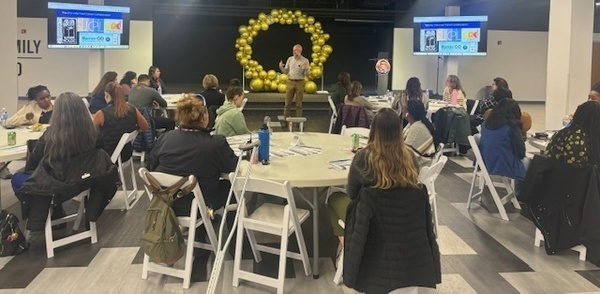
Members were encouraged to offer words or phrases to describe what comes to mind when we are asked to think of having a home. Words like: safety, security, pride, wealth, asset, cozy, and stability traveled through the room, proving that those who are housed have an undeniable advantage to having a much higher-quality day-to-day existence. “How can we expect someone to function normally in society when they are fighting daily for basic survival and needs?” Carl stated, “Well, we can’t!” “We have to be able to accommodate these limitations and help people build back their confidence and their integration back to themselves and their community.”
Hetler went on to describe a program and website, built to provide the homeless in South Bend with as many resources as possible, keeping in mind that often, these individuals do not typically have access to the internet and printing. Carl and his cohorts created a framework for the program: South Bend Cares, Connects, and Constructs. The website with resources for homelessness can be found at: https://southbendin.gov/department/community-investment/homelessness/
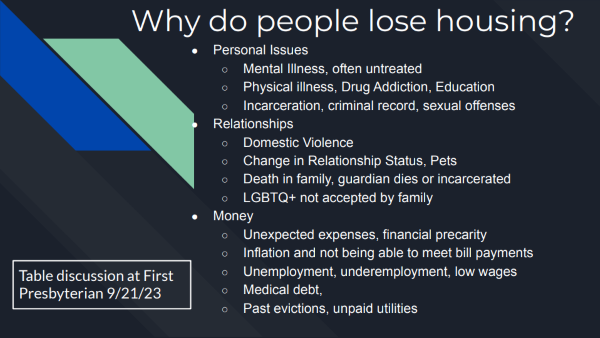
One member, a female firefighter from the City of South Bend astutely noted that none of us are immune to the risk of losing our homes, freedom, and basic needs. Homelessness is a stark reminder that circumstances can change swiftly, and any one of us could find ourselves in need, hoping for compassion and understanding from others.
Our life experiences, spanning from childhood to adulthood, profoundly shape our interactions with others and our self-perception. During the session, Carl Hetler prompted us to engage in role-playing exercises, aimed at equipping MCHC members with the skills to effectively de-escalate conflicts and facilitate a sense of safety for individuals grappling with unresolved trauma. He emphasized the power of reframing limiting beliefs, encouraging us to shift from statements like 'I can't' to more empowering expressions such as 'I can't, yet.' This approach aims to empower trauma survivors and individuals experiencing homelessness by acknowledging their potential for growth and helping them reconnect with their intrinsic needs, paving the way for personal flourishing.
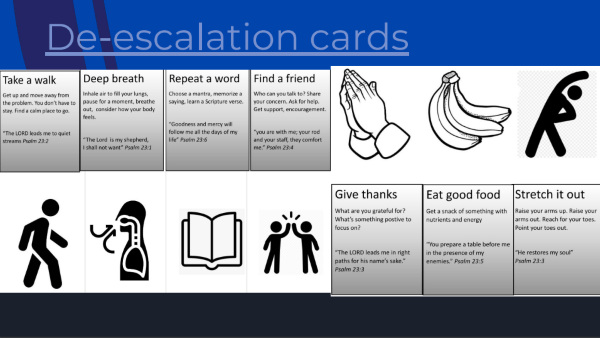
Carl underscored the primary goal of his work: to develop a dynamic website that provides up-to-date resources pertinent to our community's needs. This platform aims to offer comprehensive maps, essential points of contact, and support for basic needs and low-barrier care. In addition, he emphasized the importance of ongoing education, advocating for heightened awareness, information dissemination, and sensitivity toward trauma in others.
Central to his message was the notion of establishing healthy boundaries and clear expectations for interpersonal interactions. He cautioned against engaging in power struggles with individuals grappling with pain and instability, stressing instead the importance of empathy and inquiry into their needs. Questions such as 'What do you need?' and 'How do we break the cycle?' serve as vital tools in creating understanding and support.
Carl drew attention to the often misunderstood behaviors of homeless individuals, noting their expressions of anger and unconventional behavior. He urged us to recognize that their actions may stem from past traumas and experiences beyond the comprehension of those in more privileged circumstances. Encouragingly, he expressed optimism about the efforts in Mishawaka, where a coalition has emerged with the aim of enriching the lives of the homeless community. Through collaborative initiatives and compassionate outreach, Carl envisions a future where support networks expand, enhancing the well-being and dignity of those in need.
The Michiana Community Health Coalition will not be hosting a meeting in May, but we will reconvene in June. We extend our gratitude to our members and organization representatives for their attendance and active participation in discussing the progress on such a crucial issue in our city. We eagerly anticipate our next meeting in June!
Originally published at mchc.nd.edu .

IMAGES
VIDEO
COMMENTS
Existing research often measures a person's empathy by accuracy—how well people can label someone's face as angry, sad, or happy, for example. Alexandra Main, PhD, an assistant professor of psychology at the University of California, Merced, said curiosity and interest can also be an important component of empathy. "Mind reading isn't ...
In the past, empathy was considered an inborn trait that could not be taught, but research has shown that this vital human competency is mutable and can be taught to health-care providers. The evidence for patient-rated empathy improvement in physicians has been demonstrated in pilot and retention studies (3,4) and a randomized controlled trial .
The research behind what links our empathy to our actions determining the agenda is fascinating. As social creatures, we seem to inhibit empathetic tendencies naturally in our genetic makeup when studied. Since we have the highest empathetic behavior compared to other animals, who also show empathetic behavior, I wonder if it falls more on our ...
Empathy is a Hardwired Capacity. Research in the neurobiolgy of empathy has changed the perception of empathy from a soft skill to a neurobiologically based competency ().The theory of inner imitation of the actions of others in the observer has been supported by brain research. Functional magnetic resonance imaging now demonstrates the existence of a neural relay mechanism that allows ...
The majority of research on empathy has focused on negative emotions—typically of strangers and typically in laboratory settings. However, in everyday life, empathy was more often reported in response to positive emotions, not negative emotions, and participants empathized to a greater extent as emotions became more positive.
E MPATHY: A REVIEW OF THE CONCEPT. 2. Abstract. The inconsistent definition of empathy has had a negative impact on both research and. practice. The aim of this paper is to review and critically ...
The questions that motivate much of developmental research on empathy are: What cognitive, social, and motivational abilities does one need to have to be able to empathize with others? How—and in what sequence—do these abilities emerge in ontogeny? What drives individual differences in empathic responsiveness? Some important conceptual distinctions are drawn between automatic (involuntary ...
By contrast, the lion's share of neuroscience research in empathy has focused on two empathic processes: the tendency to take on, resonate with, or 'share' the emotions of others (experience ...
3 Components of Practicing Empathy. Practicing empathy as researchers, and including empathy as a component of any particular research method, requires a balanced awareness of oneself, one's research participants, and the research situation. This multiple attentiveness can be difficult, as the points of awareness can be in tension.
Evidence to date indicates that compassion and empathy are health-enhancing qualities. Research points to interventions and practices involving compassion and empathy being beneficial, as well as being salient outcomes of contemplative practices such as mindfulness. Advancing the science of compassion and empathy requires that we select measures best suited to evaluating effectiveness of ...
"Empathy is a building block of morality—for people to follow the Golden Rule, it helps if they can put themselves in someone else's shoes," according to the Greater Good Science Center, a research institute that studies the psychology, sociology, and neuroscience of well-being. "It is also a key ingredient of successful relationships ...
Empathy is a powerful, efficient communication tool when used appropriately during a medical interview. Empathy extends understanding of the patient beyond the history and symptoms to include values, ideas, and feelings. Benefits of improved empathetic communication are tangible for both physician and patient. 1.
Empathy is a social process by which a person has an understanding and awareness of another's emotions and/or behaviour, and can often lead to a person experiencing the same emotions. It differs ...
Empathy is the ability to recognize, understand, and share the thoughts and feelings of another person, animal, or fictional character. ... Other research finds that reading novels can help foster ...
The term "empathy" is used to describe a wide range of experiences. Emotion researchers generally define empathy as the ability to sense other people's emotions, coupled with the ability to imagine what someone else might be thinking or feeling. Contemporary researchers often differentiate between two types of empathy: "Affective empathy" refers to the sensations and feelings we get ...
Empathy is still a topic of research. The major areas of research include the development of empathy, the genetics and neuroscience of empathy, cross-species empathy, and the impairment of empathy. Some researchers have made efforts to quantify empathy through different methods, such as from questionnaires where participants can fill out and ...
Humans need social closeness to prosper. There is evidence that empathy can induce social closeness. However, it remains unclear how empathy-related social closeness is formed and how stable it is as time passes. We applied an acquisition-extinction paradigm combined with computational modelling and fMRI, to investigate the formation and stability of empathy-related social closeness. Female ...
1. Introduction. Empathy - the ability to understand and share in the internal states of others - is a complex, multidimensional phenomenon that includes a number of functional processes, including emotion recognition, emotional contagion, and emotion priming (for recent reviews, see Decety and Jackson, 2006; Singer, 2006; Walter, 2012), as well as the abilities to react to the internal ...
Empathy may not be a brand new skill, but it has a new level of importance and the fresh research makes it especially clear how empathy is the leadership competency to develop and demonstrate now ...
Empathy tools, such as personas and empathy maps, are great to understand customers, but without adequate research, these tools build on assumptions. This is why empathy workshops — where employees pretend to have a disability (e.g., wearing a blindfold) and use the company's products as a way of understanding the experiences of customers ...
To be clear, empathy doesn't have the same physiological effects as taking ibuprofen or other pain medicine. But in the chronic pain space, where patient-reported outcomes are key, patients with a better relationship with a provider they think is empathic may be more likely to discuss their pain levels. That opens fresh doors for reconsidering pain management and treatment, the researchers ...
Called "the double empathy problem," this theory by Dr. Damian Milton emerged in the early 2010s. An idea many autistic people agreed with, but until now hasn't been shown by science.
As medical professionals, the ability to navigate end-of-life conversations with empathy, clarity, and cultural sensitivity is important. Recognizing this, Texas A&M School of Engineering Medicine (EnMed) has an innovative educational experience known as the Interprofessional Practice Education, & Research (IPER) Mock Family Simulations.
As mentioned before, although research has showed the value of empathy, there are still many difficulties in regards to its implementation in the clinical practice . A relatively high percentage of health professionals, about 70%, find it difficult to develop empathy with their health care users . Age, self-reflection, appraisal, and emotions ...
Leveraging Data for Insights and Empathy-driven Design: Learn how data from tools like Google Analytics can help you pinpoint areas for improvement and prioritize usability enhancements. Remember, empathy is key - put yourself in the user's shoes to design intuitive interfaces that meet their needs.
Empathy through economics. Notre Dame's call to not just learn for knowledge's sake, but to be a force for good in the world, struck a chord with Hall. ... During his research, Hall said he learned a lot about the economics of discrimination within bias systems that are in place across many societal situations.
Central to his message was the notion of establishing healthy boundaries and clear expectations for interpersonal interactions. He cautioned against engaging in power struggles with individuals grappling with pain and instability, stressing instead the importance of empathy and inquiry into their needs.